Ulluco (Ullucus tuberosus)
Overview
- Ulluco is a tuber crop native to the Andes, where it was developed alongside the similar tuber crops potato, oca, and mashua.
- This crop is challenging to grow in the Pacific Northwest and very difficult in the rest of the country.
- Ulluco tubers are small, reaching about one to two inches in diameter on average.
- Yields can reach four pounds per plant in favorable climates, but are usually much lower.
- The tubers are vividly colored in yellow, orange, red/purple, green, or white, sometimes with spots.
- The tubers have a much firmer texture than potatoes and taste like a combination of beet and potato.
- The leaves of ulluco are also edible and can be used like spinach.
- Ulluco thrives under very narrow climate conditions and grows poorly where summer temperatures exceed 75 degrees.
- Tubers are produced during the short days of fall and are not ready for harvest until mid-November.
- The crop is propagated by planting tubers. True seeds are rare and used only for breeding.
- Disease is a significant problem for ulluco and many varieties are infected with viruses. I do not recommend growing any heirloom ulluco varieties unless they have been tested and confirmed to be virus free.
This guide provides information about growing ulluco in North America, and particularly the Pacific Northwest, which is the only place that I have experience growing it. Much of the information will apply anywhere, but considerations about the timing of planting and harvesting, climate, photoperiod, and pests and diseases will vary considerably by location.
About ulluco
Description
Ulluco (Ullucus tuberosus), pronounced oo-YOO-ko, is a member of the family Basellaceae, which contains a few other edibles such as Malabar spinach (Basella alba). It is found primarily in Peru, Bolivia, Ecuador, and to a lesser extent in Colombia, Venezuela, Argentina, and Chile. It is also commonly known as papa lisa, olluco, or melloco in the central and southern Andes and as ruba or chugua in the northern Andes. It is most widely known as olluco in Spanish, so you might wonder why “ulluco” is the preferred spelling in English. The reasoning is fairly arbitrary. Ulluco is known by dozens or possibly even hundreds of names in the different languages of the native peoples of the Andes, but in the Quechua language of the central Andes, it is most commonly called ulluku. Since Quechua does not have a written form, this name is Latinized in various ways. The scientific name for the genus, Ullucus, is based on the Quechua name, and that is probably why we prefer ulluco to olluco in English. No Latinization is more correct than the others, but ulluco is the most common. If you prefer olluco or ulluku, you’re not wrong, but you will need to make sure to search for information in English under ulluco for the best results.
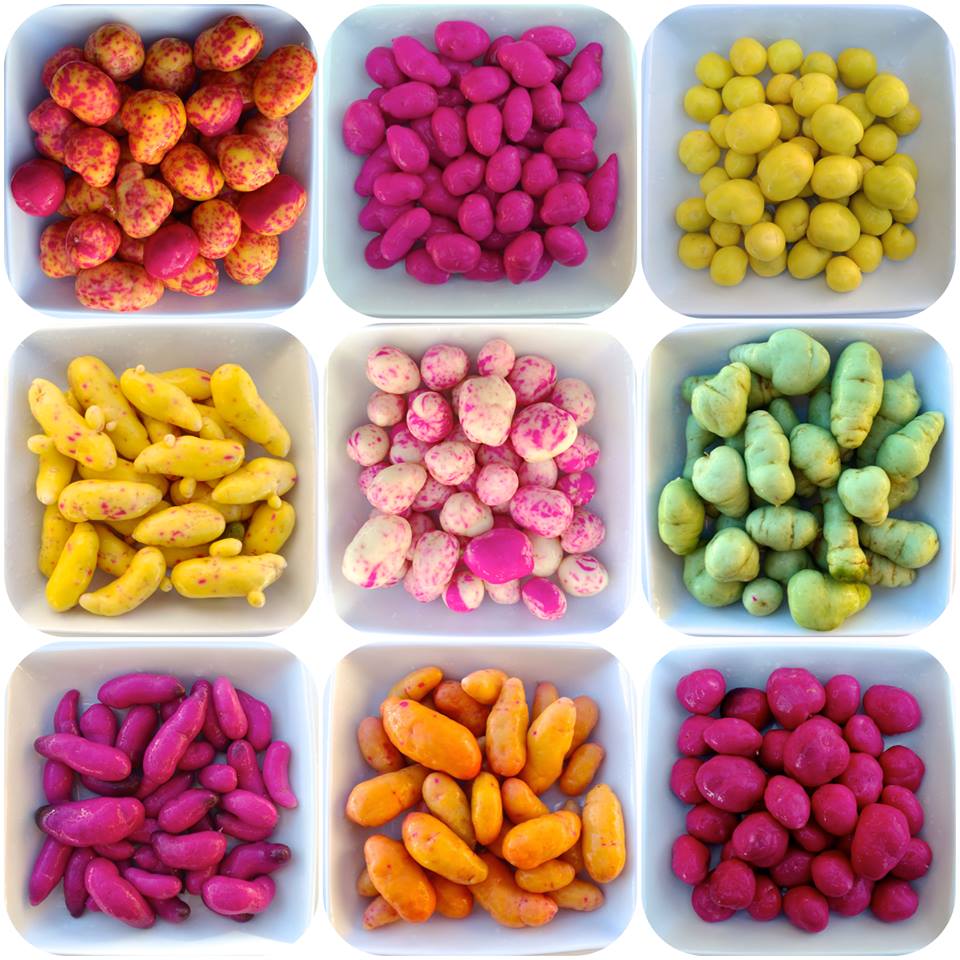
Plants may grow up to three feet (91 cm) in diameter and typically reach a maximum height of about fifteen inches (38 cm) before sprawling. Leaves and stems are succulent. Stems range green to red, are angular in cross section, and often have different coloration at the edges.
An ulluco plant forms a large number of tubers, easily more than one hundred, but at least half of them are often too small to eat. The remaining half typically ranges from about a half inch to three inches (1.25 to 7.5 cm) in their largest diameter. There are Colombian varieties that are said to be the size of a fist (NRC 1989) but I haven’t seen them and I’m not sure whose fist they are being compared to. Tubers are often round, but may also be oval, or long and curved or twisted. Large tubers sometimes contain a void, particularly after long storage.
Ulluco tubers are very colorful, including white, yellow, orange, red, green, and purple, but come in a fairly restricted range of color values. That is, yellow varieties are typically all the same yellow, orange are all the same orange, etc. This is in contrast to a crop like oca, where the tuber colors come in an almost unlimited spectrum of shades and tints. Some varieties are spotted or streaked with a second color. Tuber flesh is white or yellow.
Ulluco is a popular crop in its native region, but is little grown outside the Andes due both to difficulties with cultivation and the fact that the potato arrived in Europe first. Outside the Andes, it is probably the most well known in New Zealand, where it has been cultivated for about 20 years and a mutation breeding program has produced new varieties. They have renamed ulluco “Earth Gems” in New Zealand, a romantic but hopefully unnecessary appellation.
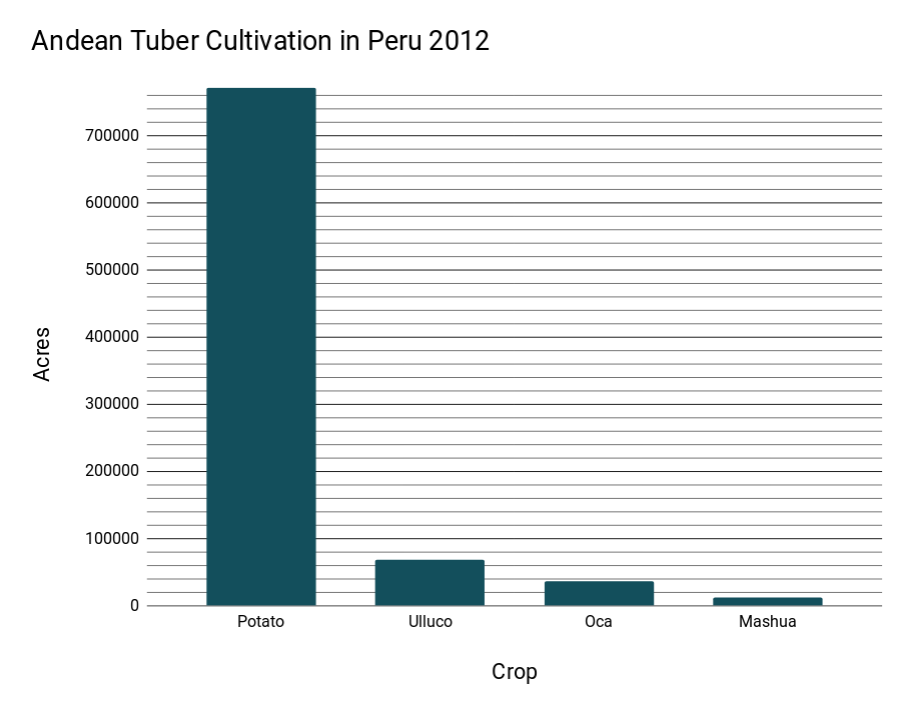
In addition to the domesticated ulluco, which is diploid and occasionally triploid or tetraploid, ulluco has a “wild” or feral subspecies (subsp. aborigineus) which is usually triploid, but occasionally diploid. The diploid wild ulluco may be the progenitor of domesticated ulluco or merely a feral form. The subspecies appears to set invariably small, pink tubers. Plants are decumbent, with vines ranging anywhere from 1 to 10 feet (30 cm to 3 m) in length. The tubers are somewhat bitter and more mucilaginous than the domesticated varieties. This wild ulluco may have promise as a perennial leaf vegetable, even though the tuber crop is not really worthwhile by itself.
In Colombia, there is a unique group of seemingly intermediate ullucos cultivated in the northeast Andes that appear similar to wild ulluco, with long stems and smaller tubers, but color and flavor characteristics of domesticated ulluco (Parra-Quijano 2012). The earlier introductions may represent a significant source of diversity and divergence from central Andean varieties.
History
Ulluco is a fully domesticated crop. Although there are feral types, no wild relatives have been conclusively identified. Archaeological evidence exists for human use in the central Andes going back 4250 years (NRC 1989). Ulluco may have been introduced to Colombia from the central Andes twice, once from semi-domesticated sources and then later from domesticated sources (Parra-Quijano 2012).
Information is not available over its entire range but, in Ecuador, loss of varieties amounting to 37.6% of its previously assessed genetic variability has occurred in recent decades (Tapia 2001). Although its genetic diversity has declined, cultivation has increased significantly since the 1960s and ulluco is probably not in danger in the Andes like some of the less well accepted root and tuber crops are. Unlike many of the native roots and tubers, ulluco is well known and widely available in the Andes (NRC 1989). Ulluco is often sold along with potatoes in lowland markets.
Nutrition
 Ulluco is a good source of carbohydrate, with about 20% less calories per serving than potato. It is very high in vitamin C, with more than twice as much potato.
Ulluco is a good source of carbohydrate, with about 20% less calories per serving than potato. It is very high in vitamin C, with more than twice as much potato.
The colors of ulluco are the result of high concentrations of many different betalains: pigments that are also found in beets and that appear to have antioxidant activity. Red/purple varieties have high concentrations of betacyanins, as much as 70ug/g, according to Svenson (2008). Yellow/orange varieties contain betaxanthins, as much as 50ug/g (Svenson 2008). Some of the betalains in ulluco have not been found in any other edible plants. There is a growing body of work showing that betalains have a number of positive health effects, including antioxidant, anti-inflammatory, and even anti-cancer activity. These pigments are available from relatively few edible plants (primarily beets and cactus fruits), unlike the much more common group of anthocyanin pigments, so ulluco can be a valuable addition to the diet.
Incidentally, once you understand that the colors of ulluco are produced by betalains, you can start to find other related plants that have similar color patters. Beets, while generally not as vivid, have many of the color combinations found in ulluco. But if you really want an impressive side by side combination, take a look at prickly pear and pitaya cactus fruits. Cacti are in the order Caryophyllales along with ulluco and they share the same pigments. You can really see the similarities once you know to look for them.
Cooking and Eating
Ulluco can be eaten raw or cooked, but it is most common to cook it. It is difficult to describe the experience of eating ulluco, although it is not so unusual that it couldn’t be passed off as a potato under some circumstances. The flavor varies primarily in “earthiness” or beet-like flavor. Some varieties have a very strong beet flavor, while others have almost none. Texture varies in density and mucilaginousness. The tubers remain firm even after long cooking times that would cause a potato to disintegrate. Some varieties have a density that invites comparisons to boiled nut. It isn’t quite that dense, but that is as close a comparison as I have heard. Other varieties are much softer, firm around the outside, but very soft at the center after cooking. Ulluco flesh is mucilaginous: raw, it has a slimy texture that will be familiar to anyone who has eaten okra or nopales. Cooking makes most of the sliminess disappear. Small tubers are firmer and less slimy. Some varieties are more mucilaginous than others and large tubers tend to be a little slimier. Usually, when cooked, this only contributes to the “smooth” texture of ulluco, without being noticeably slimy. For example, I find okra really difficult to eat, but ulluco doesn’t bother me at all.
The earthy flavor of ulluco is probably its most controversial feature. Some people find this flavor to be unpleasant, with a “musty” aspect. I think it is delicious, but preferences vary. The earthy flavor is caused by geosmin, a bicyclic alcohol usually produced by bacteria (Wikipedia:Geosmin). It is also responsible for the odor that occurs following rain after a dry period, known as petrichor, and is one of the odors produced by freshly dug soil (Wikipedia:Petrichor). I’m not sure yet if this is true, but it appears that varieties with yellow/orange flesh tend to have strong flavor, while varieties with white flesh may have little to no beet flavor. I prefer ulluco varieties with strong earthy flavor, but it seems that is not a universal preference. Sensory evaluation in New Zealand determined that consumers prefer mild flavored varieties.
All parts of the plant are edible at all stages of growth. Tubers will become green when exposed to light, but this does not alter flavor and they do not become toxic like potatoes do. The tubers are the primary part used as food, but the leaves are similar to spinach and can be eaten raw or cooked.
The tubers are small compared to potato; most are one to two inches (5 cm) in diameter, but they are typically cooked whole with the skin on and require no preparation other than washing. I regard varieties as belonging to two categories: soup and roasting types. Traditionally, ulluco is probably most commonly prepared in soups and stews. Smaller types with higher tuber counts make better soup ullucos, as they are bite sized and only need to be rinsed and tossed into the soup pot, where they will both thicken the broth and remain intact even with long boiling. Soup types are also good for eating raw in salads. Roasting types produce a smaller number of larger tubers and these are best roasted with meat or other vegetables. They are also more suitable for slicing and dicing than soup types. They are commonly boiled whole or cut and fried. They substitute well for potatoes and beets in many recipes. They don’t mash very well on their own, but make a nice addition to mashed potatoes; if you replace a quarter of the potatoes with ulluco (particularly large ulluco tubers), you can skip adding butter or milk and achieve a similar texture.
As is true of many vegetables, ulluco loses color when cooked. You can minimize color loss by acidifying cooking water and by minimizing cooking time. Long cooking time, like in a slow cooker, will usually result in almost total color loss. Adding ullucos near the end of cooking will preserve much of the color. Yellow varieties tend to retain their color better when cooked than red varieties.
Dehydrated ulluco leaves have been studied as a potential breakfast cereal replacement (Armas Cevallos 2016). Apparently, given the thickness of the leaves, they dry down to a size similar to cereal flakes.
People sometimes experience a change in the color of urine or feces after eating a lot of ulluco. This is known as beeturia, a condition where your body cannot break down the betalain pigments in ulluco. People most commonly experience this when eating beets, but ulluco is colored by the same group of pigments. Most medical information indicates that this is a harmless condition that occurs in about 10% of people, but it may indicate either an iron deficiency or excessive oxalate in some cases.
Cultivation
You can grow ulluco very much like potatoes, but it tolerates a narrower range of climate. The plant is similar in size, although more sprawling than potato. Whole or cut tubers are planted in spring. Planting occurs at about the same time as for main crop potatoes, although harvest takes place later than for most potatoes. With high yielding varieties like Pica de Pulga, Purple, and Cusco Market, I have gotten as much as 2.5 lb (1.1 kg) from individual plants, but a yield of 1/2 to 1 lb (227 to 454 g) per plant is more typical in less ideal climates.
Climate Tolerance
Ulluco likes water and prefers shade where temperatures frequently exceed 75° F (24 C). It will produce much better yields in full sun where summer temperatures are cool enough to allow it.
Ulluco will grow well in North America anywhere along the west coast where you experience coastal fog in the summer. The five mile coastal strip from Vancouver, BC to San Francisco, CA is probably the best growing region for ulluco on this continent. Some people are also having success along the coast in southern California, but others have reported failure. It may depend on the year and how much you water the plants in that region.
The inland Pacific Northwest, west of the Cascade Mountains is another good area. You will sometimes have difficulties with summer weather and the ulluco may suffer in warm years, but will be fine most of the time. In Seattle, you can probably get an ulluco crop in most years; in Portland, the odds are not quite as good, due to higher summer temperatures. We have mixed reports from Oregon’s major agricultural region, the Willamette Valley, where there will often be a sufficient frost free season, but also a bit too much summer heat.
Along the east coast, ulluco is primarily grown in the Appalachians at elevations where summers are cool but autumn is still sufficiently long to mature the crop. There are some reports of success along parts of the coast, from North Carolina to Maine, but also some reports of failure. You need to take a close look at your microclimate to see if you can supply a long enough frost free season while staying under the 80° F (27 C) mark in the summer.
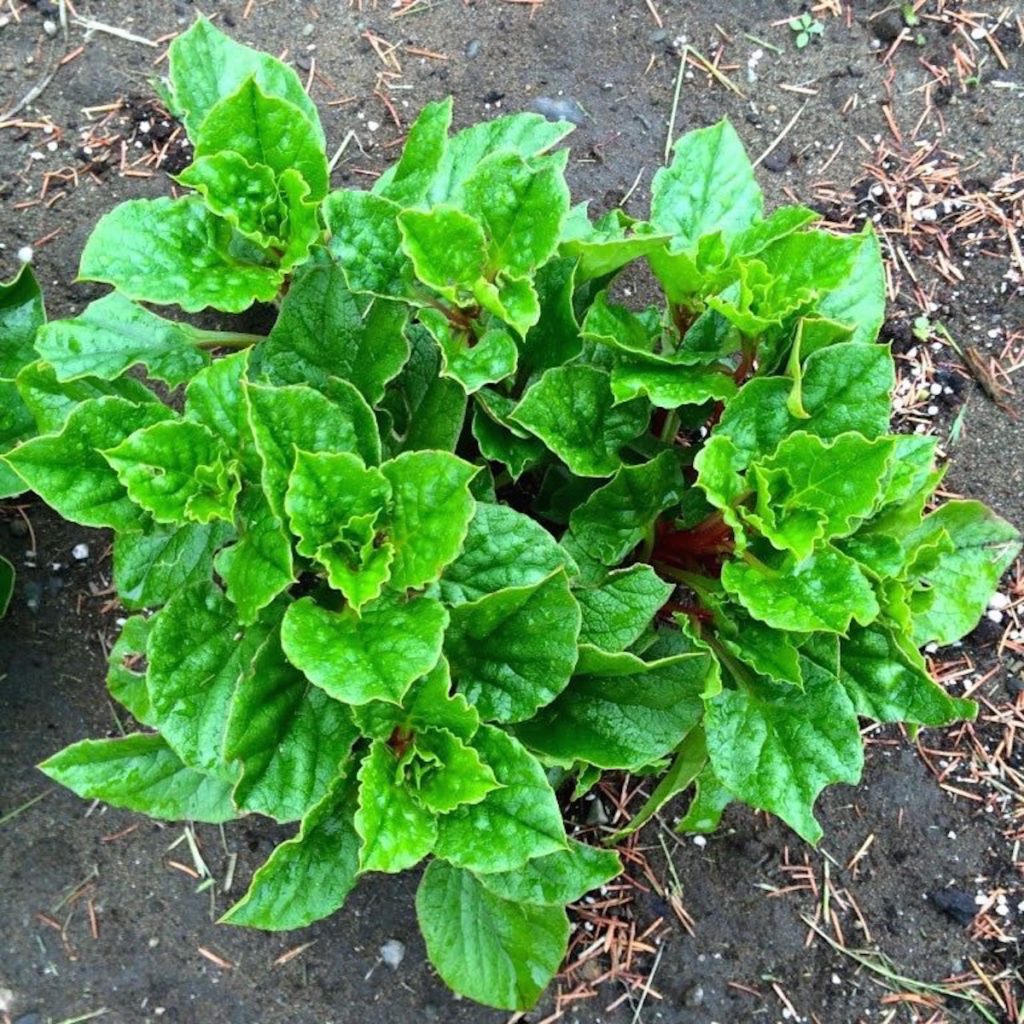
You can grow ulluco almost anywhere if you are willing to take steps to protect the plants and if you don’t care about producing high yields. In cold zones, you can extend the season in a greenhouse. In hot zones, you can grow the plants in containers and move them into heavy shade or indoors when the weather gets hot. You won’t harvest a huge crop this way, but if you just want to grow a few plants, it’s certainly manageable. Ulluco makes a nice houseplant, but won’t get enough sun to produce a heavy crop of tubers indoors. It really needs to be grown in full sun in order to produce a good crop, so you can keep ulluco alive in hot areas by moving it into shade, but your harvest will suffer.
Ulluco best fits USDA zone 9a (low temperature of 20 to 25° F). Approximately 75% of the tubers can be expected to survive a multiple day freeze at 25° and approximately 50% at 20°, although you can improve on this by mulching over the plants. Ulluco is reported to be resistant to frost (NRC 1989) but I have found that it only handles very mild frosts. The tubers are surprisingly resistant to freezing, as noted above; ulluco tubers will still be viable after freezes that turn potatoes, oca, and mashua to mush.
Photoperiod
The more that I have observed ulluco, the more that I have come to regard its tuberization as a complex process. I haven’t read any research that describes this, but perhaps that is because ulluco is so rarely grown under long day conditions. Under long day photoperiod, many ulluco varieties go through two stages of tuberization. Primary tuberization occurs on underground stolons, clustered closely under the base of the plant. Secondary tuberization begins when the plants drop descending stolons from the stems to the soil and form tubers over a much larger area. Secondary tuberization is very clearly controlled by photoperiod; the descending stolons do not begin to form until day length has reduced to 13 hours or less (12 hours or less in most varieties). Primary tuberization does not appear to be controlled by photoperiod as much as it is by maturity of the plant, but this is hard to determine conclusively without growing the plants under carefully controlled conditions, which I am not able to do. Some varieties begin primary tuberization under long day conditions, as early as July here. The tubers do not grow as quickly as they do once short days arrive, but the head start means that primary tubers are always the largest that the plant forms. Secondary tubers begin to form after the autumn equinox and have only a few months to develop before frost kills the plant, which probably limits their size.
You can possibly stimulate tuber formation earlier in the year by blocking light from reaching your plants. Blacking them out to artificially reduce day length beginning two or three weeks before the equinox may get you tubers that much sooner.
Soil Requirements
Ulluco thrives even in relatively poor soils, but loose, light soils benefit you at harvest time. Moderately acidic soils are ideal, but ulluco doesn’t seem to be too particular. It is better to add compost than fertilizer. Ulluco doesn’t expect much and overly rich fertilizer may harm the roots. Cordova (2017) found that earthworm castings made a better fertilizer for ulluco than goat manure.
Propagule Care
Small tubers can suffer dehydration. Keep them in a dark, cool place. Check on them from time to time. If you find that they are becoming soft, either put them in some barely damp soil or in the crisper of your refrigerator. Even badly desiccated ulluco tubers that start to look like raisins will usually survive if introduced to some damp soil.
Tubers will begin to sprout by March if kept at room temperature. Sprouted tubers can wait to be planted for a month or more, so it is not an emergency. It is best to store the tubers where they can get some light once they have sprouted; sprouts that grow in darkness will become spindly and fragile. I recommend potting the tubers in some barely damp soil with the tip of the sprout exposed and then transplanting after the last frost. Ulluco is very tolerant about transplanting and you will get a head start by potting them. You don’t have to pot them individually; you can put a bunch in a single container and then divide them when you transplant.
Planting
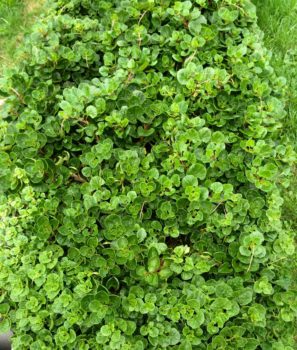
Plant ulluco in the spring after risk of frost has passed. Don’t get in a rush. Frost will kill new growth and ulluco won’t begin to form tubers until after the autumn equinox (about September 21), so there is no advantage to very early planting. In the Andes, some varieties may produce a crop in as little as 5 or as long as 9 months, but the average is 6 to 8 months (NRC 1989). So, on average, the plants need seven months to produce good yields. Count back from your average first frost date to find the right time to plant. If your growing season is shorter than seven months, you can start the plants in pots. The trickier part will be keeping them alive until at least the middle of November in a short season climate.
Plant at a depth roughly equal to the diameter of the tuber. In row spacing of 15 inches (38 cm) works well for domesticated types. 36 inch (91 cm) row spacing will leave a comfortable walkway. 24 inches (61 cm) between rows will usually leave just a little walking space in between. 18 inches (46 cm) between rows will form a dense, unbroken canopy.
Vining types (wild ulluco) are best grown on mounds, planted in the center, allowing the vines to trail down the sides.
Ulluco grows as a thick ground cover and is able to suppress weeds very effectively when densely planted, but it will take a while to close the canopy and requires regular weeding until then. I don’t recommend growing ulluco with any kind of sheet mulch, because the stems drop descending stolons to the ground. If those stolons cannot penetrate into the soil, you will lose much of the possible yield.
I don’t recommend cutting your seed tubers. It can work and is particularly tempting with larger ones, but it often ends in tragedy. If you insist on cutting, make sure the pieces have at least two eyes. They are not easy to see, so it is best to cut after the tubers have sprouted.
Management
In the autumn, once the day length falls to about 12.5 hours, you will begin to see very thin stolons forming on the stems. These will drop to the ground, where they will form tubers. This same process is occurring below the ground, wherever the stems touch, and those will be the source of your earliest and largest tubers. If you very carefully add some light compost over the center of each plant at this stage, you can increase your crop because the stolons will be able to begin forming tubers more quickly. Ulluco stems are brittle at this stage of growth, so careless hilling will have the opposite effect.
Companion Planting
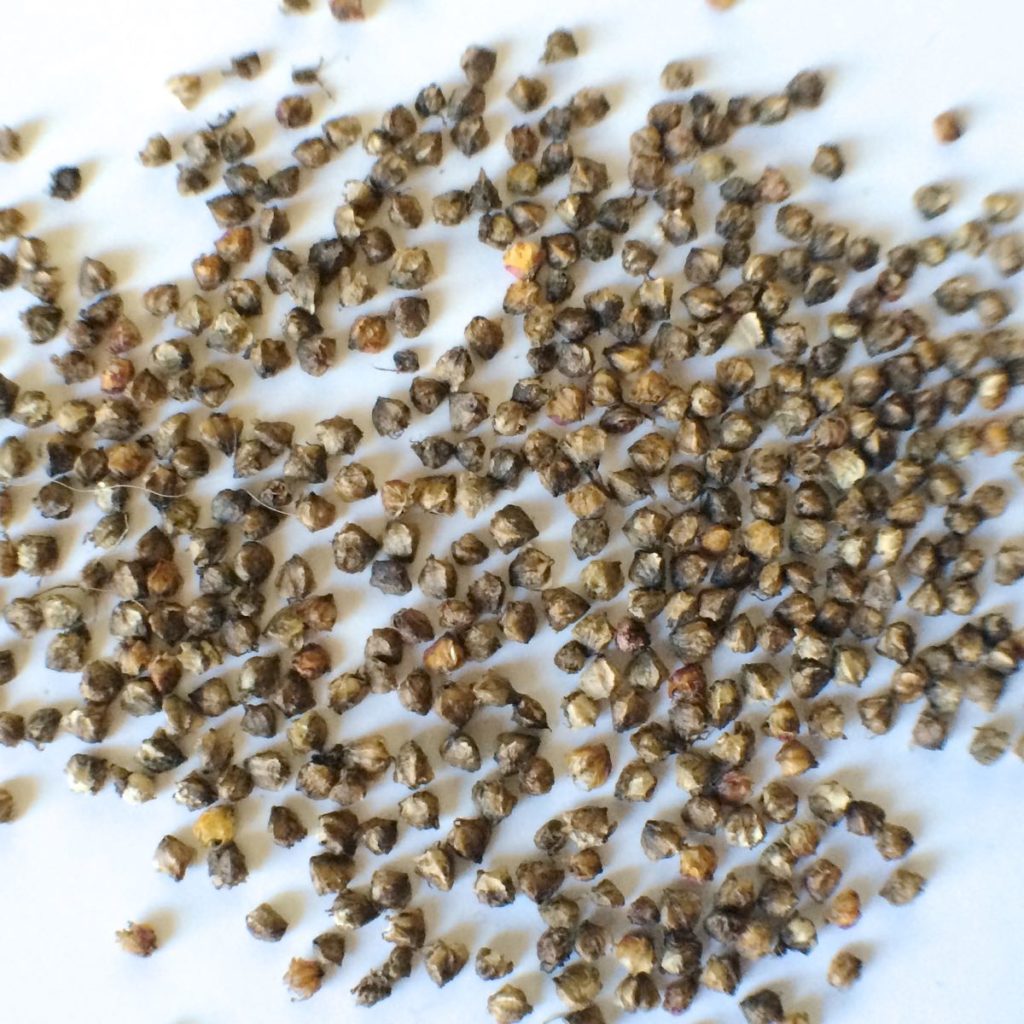
Like oca, ulluco can be intercropped with garlic or onions with reasonably good results. These plants will be harvested before the ulluco plants grow really large in the fall. The tricky part is water. Ulluco needs plenty of it in the summer, while water is normally withheld from garlic and onions preceding harvest. I haven’t found this to be a big problem, but I don’t really have any choice, since nature usually takes care of the watering for us.
Growing as a Perennial
Ulluco is a perennial by virtue of its tubers, which survive winter dormancy to produce new plants in the spring. The aerial plant will not survive for more than one year in any climate; where not killed by frost, it will eventually senesce. This situation is similar to the potato and other Andean tubers like oca and mashua.
Growing ulluco as a perennial is not ideal for producing large yields. All of the tubers will sprout in subsequent years, crowding the plot and producing smaller tubers with each generation. In addition, ulluco is relatively vulnerable to diseases that may accumulate when it is grown repeatedly in the same soil, particularly Fusarium and Verticillium.
The nearest thing to growing ulluco as a perennial may be the “sloppy harvest” method, where only the large tubers are taken and small tubers are left behind to grow again. This certainly works for some people, but it risks the problem of unintentionally selecting for small tuber size and accumulating soil pathogens.
Container Growing
I don’t recommend growing ulluco in containers. You can do it and the plant may look fine but, in my experience, the yield is always much worse than plants grown in the ground. If you want to try it, best to try large containers like half barrels.
Propagation
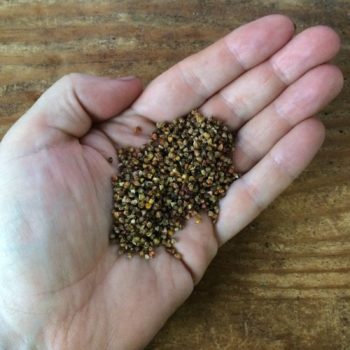
One of the most fascinating mysteries of ulluco for me is that there are hundreds of different, incredibly diverse varieties, but apparently with almost no sexual reproduction, usually the main generator of genetic diversity. The ulluco collection of the International Potato Center includes 360 varieties. Where did they come from? We know that the other Andean tuber crops potato, oca, and mashua occasionally form true seed in the field and that volunteers from seed get incorporated into the crop. This has probably been the main source of variety development historically (before the advent of intentional hybridization). Presumably this happens with ulluco too, but it has never been reported. Beyond the fact that it hasn’t been reported, there are other factors that suggest that it must be very rare, like the fact that the plants don’t set seed here under short day conditions and that large number of white ullucos are produced from seed, but none are cataloged from the Andes. Did most of these varieties arise from somatic mutation? If so, how long did that take? How old are the Andean clones? Was there more sexual propagation at some point in the past? For example, there are some ruins like Moray that suggest that the Incas may have been fairly sophisticated agronomists. Were they doing a more modern style of plant breeding at some point, rather than just farmer selection? Or was ulluco relocated from a climate where it more easily set seed? There is no clear wild progenitor of ulluco in the Andes, so perhaps it developed elsewhere and since went extinct in its original range. I can’t answer any of these questions, but they are certainly interesting to think about.
Vegetative Propagation
Ulluco is planted almost exclusively from seed tubers. It is capable of producing sexual seed, but only under very narrow environmental conditions. Even when seed is obtained, it has a low rate of embryo formation and is very difficult to germinate.
It is also possible to propagate ulluco with stem cuttings. Sections of ulluco stem root easily and quickly in water or wet soil. They will even form tubers while rooting in water if the lighting period is 12 hours or less. Ulluco roots so easily that it may be possible to simply chop up stems and cover them lightly with soil, as long as the conditions are wet enough.
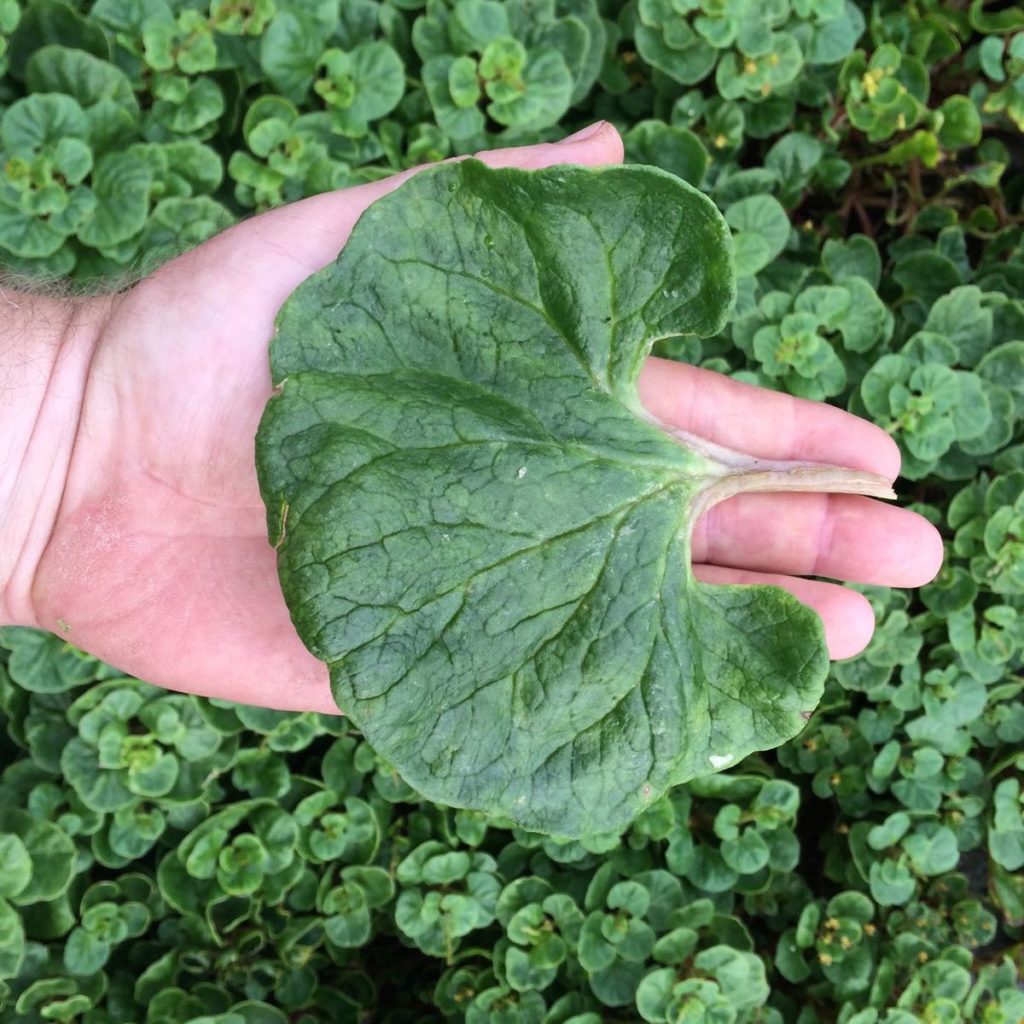
Although ulluco is difficult to breed sexually, due to low production, it is possible to select for improved lines asexually. Ulluco mutates frequently and I have observed changes in tuber size, coloration, and shape. It doesn’t take too many generations of selection to have an impact. In New Zealand, they have been using gamma irradiation to induce mutations in order to produce new varieties and have had success introducing new colors and low geosmin content (Pathirana 2011).
Octoploid ullucos have been produced by treatment with oryzalin (Viehmannova 2012). It may be possible to produce varieties with better yield or other desirable characteristics by increasing the level of ploidy.
Tissue Culture
Ulluco can be propagated on full strength Murashige and Skoog medium with vitamins and 20mg/L table sugar. The best explants, in my experience, are nodes taken from the upper portion of a tuber sprout. I normally keep tubers that have been carefully cleaned in paper bags until they have produced sprouts four to six inches long and then take nodal segments from the upper half of the sprout. Sterilize explants with a 1 minute soak in 70% ethanol or isopropyl, followed by a five minute soak in a 1% bleach solution. Longer sterilization is usually damaging to ulluco. Because of the relatively short sterilization, I recommend using a preservative in the medium. On occasion, varieties show signs of endogenous bacterial contamination, which can be reduced sufficiently for culture by putting nodal segments in a 24 hour soak in liquid M&S medium supplemented with PPM, tetracycline, or both, before culturing. Meristem culture will also avoid endogenous contamination, but I prefer to take meristems from established cultures.
Ulluco explants will usually sprout on plain M&S medium, but require an auxin to do much rooting. A 16 hour photoperiod works best when on rooting medium. Short photoperiod slows rooting and increase shooting.
Sexual Propagation
Like many of the Andean tuber crops, ulluco has been primarily vegetatively propagated for a very long time, perhaps for hundreds or even thousands of generations. This kind of propagation generally has a deleterious effect on the sexual reproduction system of the plant and that appears to be the case with ulluco. Sexual reproduction has been rarely observed in ulluco and it was largely considered to be a sterile plant before seed and seedlings were produced at the University of Turku in the late 1980s and early 1990s, in a research program that was sadly discontinued.
Happily, we have had some success producing seeds with hand pollination since 2013 and obtained our first seedling in 2015, quickly followed by a few more. It appears that we have a sustainable breeding program, with seed-grown varieties producing viable seed of their own. We now have nearly 100 seed grown varieties and will probably rocket past that in 2018. Of the 19 heirloom varieties available in the US, we were able to get seeds from seven: BK09510.2 from Peru, BK10425.2 from Peru, Chugua Roja from Colombia, Colombian Long Red, Cusco Market from Peru, Pica de Pulga from Bolivia, and Round Yellow from Ecuador. The Colombian varieties and BK10425.2 from Peru were by far the best seed producers. With most of the others, we were lucky to get a single seed on each plant. These were pollinated from all 19 varieties, but because I have much better results pollinating from multiple sources, I don’t usually know what the pollen parents were. Hopefully, at least some of the 11 varieties that did not set seed contributed pollen. Seven varieties isn’t much of a genetic base for a breeding program, but it is probably good sign for genetic diversity that these varieties were collected over a very large area. So far, our seed grown ullucos have appeared reasonably diverse. Hopefully, at some point it will be possible to request varieties from the International Potato Center genebank. Distributions to the US have been halted for more than ten years. With access to a greater range of varieties, we could probably accomplish a lot.
| Female Parents Used in the Cultivariable Ulluco Breeding Program | ||||||
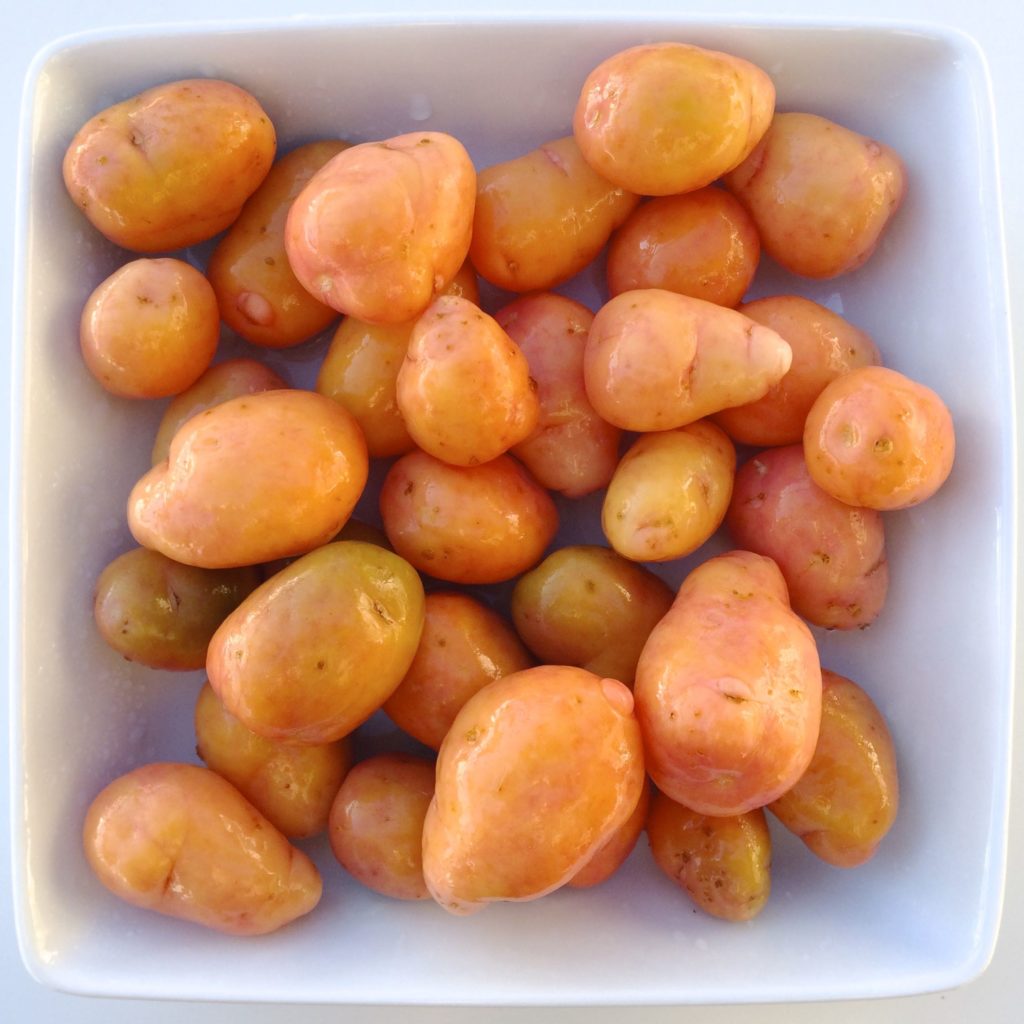 |
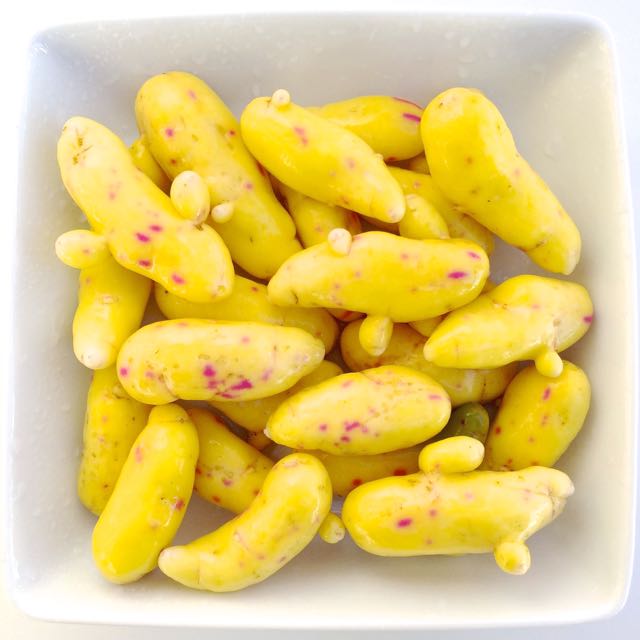 |
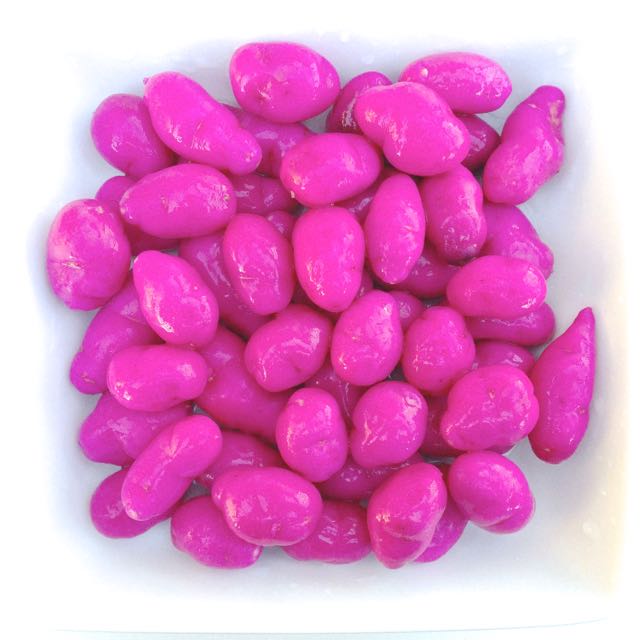 |
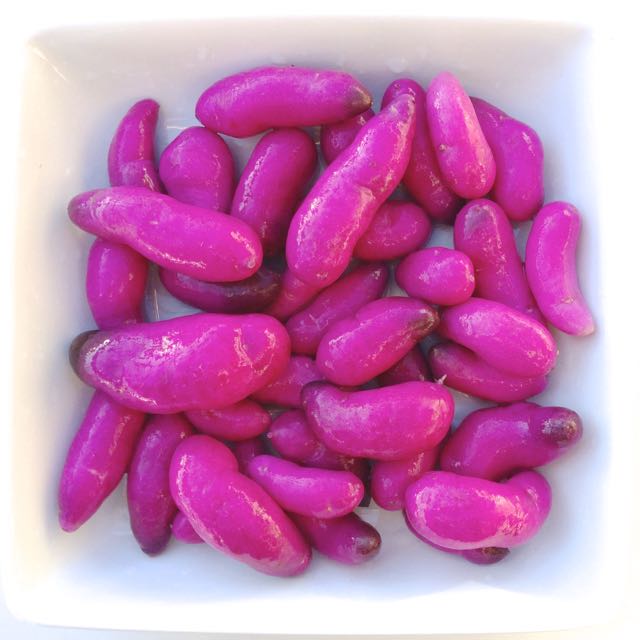 |
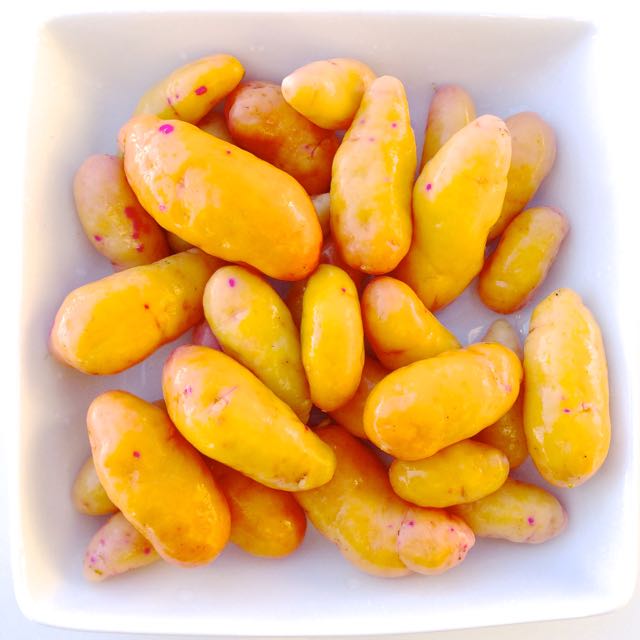 |
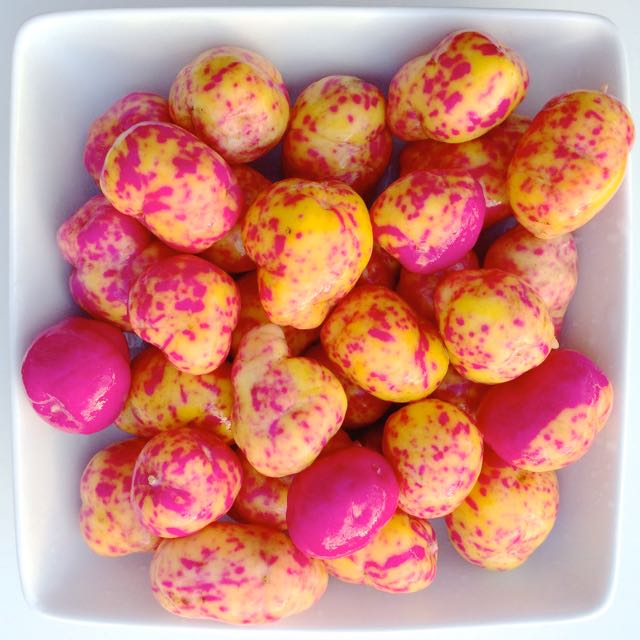 |
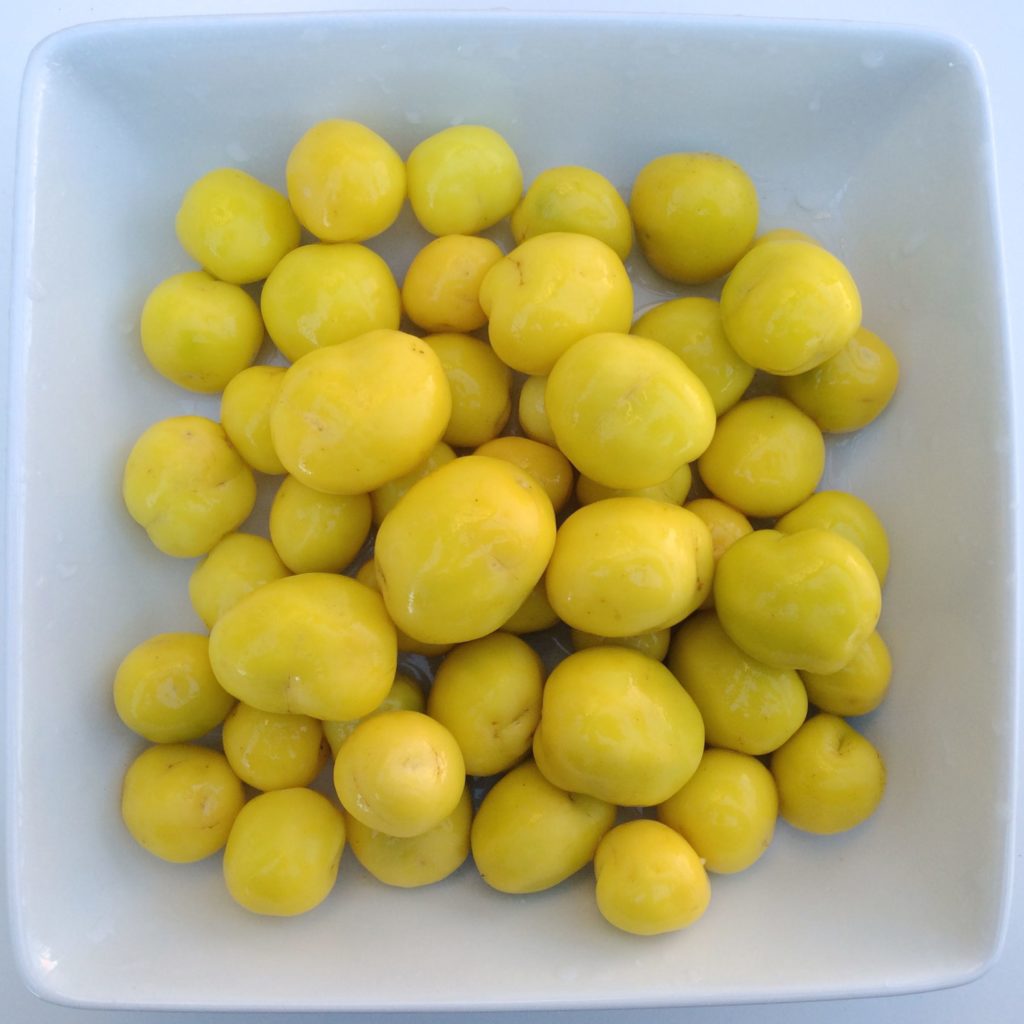 |
| BK09510.2 | BK10425.2 | Chugua Roja | Colombian Long Red | Cusco Market | Pica de Pulga | Round Yellow |
Ulluco typically flowers beginning about two months after planting and most varieties flower profusely. Flowering and seed set continues in most varieties until the onset of tuber production in the fall. The flowers produce a single dry fruit which contains a single seed (Rousi 1988). Ulluco is an obligate outbreeder (Pietila 1995) or nearly so. I have found a very small number of seeds on caged plants, but most varieties have produced no seeds without cross pollination. I have seen almost no pollinator interest in ulluco. Ants occasionally appear to work the flowers. In order to get seed, we hand pollinate with a small brush. This process is pretty laborious. I have often spent as much as four hours per day crawling between the plants and transferring pollen from one row to another. In 2016, I determined that I can perform about 40 ulluco pollinations per minute. I get a seed from about 1 in 400 pollinations. If I spend two hours per day pollinating ulluco, then I can expect 12 seeds. If I do this every day for 80 days, then I can collect about 960 seeds for the year – and that is just about what I have been collecting the past few years. With a germination rate over four years of about 4.4%, I can expect about 42 seedlings for my effort. So, it is an investment of about four hours for each ulluco seedling. Happily, the rate of seed set appears to be better in some of our seed grown varieties, so I hope that these numbers will get a lot better in the future.
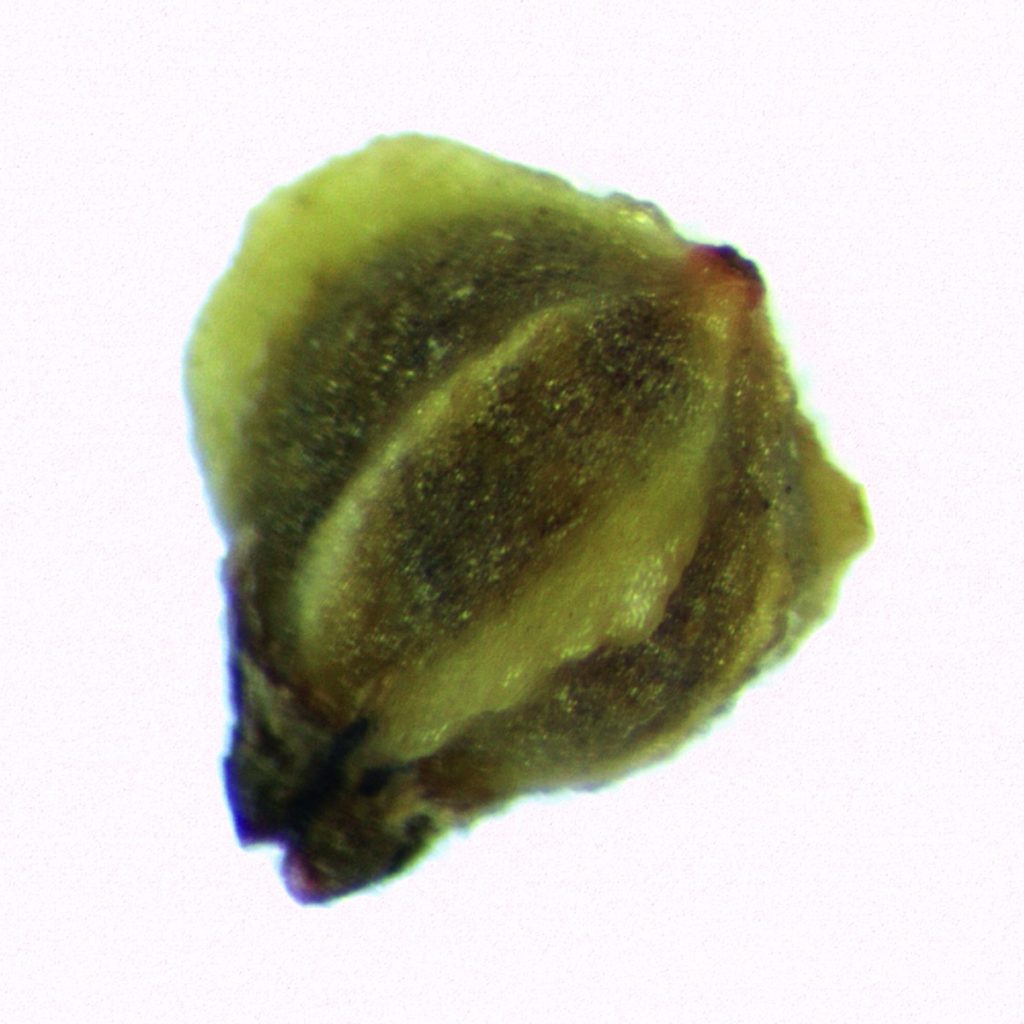
Genetic load is the presumed cause of ulluco’s poor sexual reproduction, resulting in embryonic abnormalities that cause aborted seed production (Pietila 1994). Genetic load is an accumulation of traits that reduce fitness and is higher in plants that experience high rates of mutation (because mutations usually reduce fitness). Ulluco appears to have a fairly high rate of mutation, based on the high rate of somatic mutations observed in clonally propagated varieties. Among ulluco seedlings, I have seen a high rate of abnormalities that may also be consistent with genetic load, including malformed or missing cotyledons, lack of epicotyl development, and albinism. Seedlings have also been observed to lack such critical features as radicle and plumule (Pietila 1995). It also seems very likely that the virus burden in most heirloom ulluco varieties probably reduces fertility. When cleaned of viruses, most varieties are able to produce some seed.
Ulluco seed has dormancy, which typically lasts for a minimum of 4 months (Lempiainen 1989). Germination takes place over a long period. I have seen seed germinate as little as twelve days after sowing, but rarely. The majority of seedlings germinate after a period of 290 to 650 days (Lempiainen 1989). Reserve a space for the long term for ulluco seed starting, because you will probably be waiting for years to see the last to germinate. As of 2018, we are still getting germination from seeds that were sown in 2014.
Lempiainen found a total germination rate of 2.04% for 1177 seeds. That is in close agreement with the results here for the first two years, which produced 2.7% germination. We have now reached 4.4% germination in the fourth year since sowing. I have had the best results germinating ulluco seed in an unheated greenhouse in summer and fall. This may be an indication that warm daytime temperatures and very cool night temperatures encourage ulluco germination.
It has been difficult to identify the best conditions for ulluco germination due to the low success rate. Experiments with scarifying seed have been inconclusive; there does not appear to be a significant advantage to filing or chipping the seed coat. Seeds should be planted about 1/4 inch (6 mm) deep. The soil should be kept wet. If algae and mosses grow on the surface, that is a good sign that it is wet enough to germinate ulluco, although you need to break up any mosses that bind the surface of the soil so that germinating ulluco seedlings can emerge. If germinating under controlled conditions, I have found that 12 hours at 80° F (27 C) followed by 12 hours at 55° F (13 C) produces the fastest germination. I have also found that similar results occur with seed germinated in our unheated greenhouse in late summer and fall, when a similar temperature range occurs.
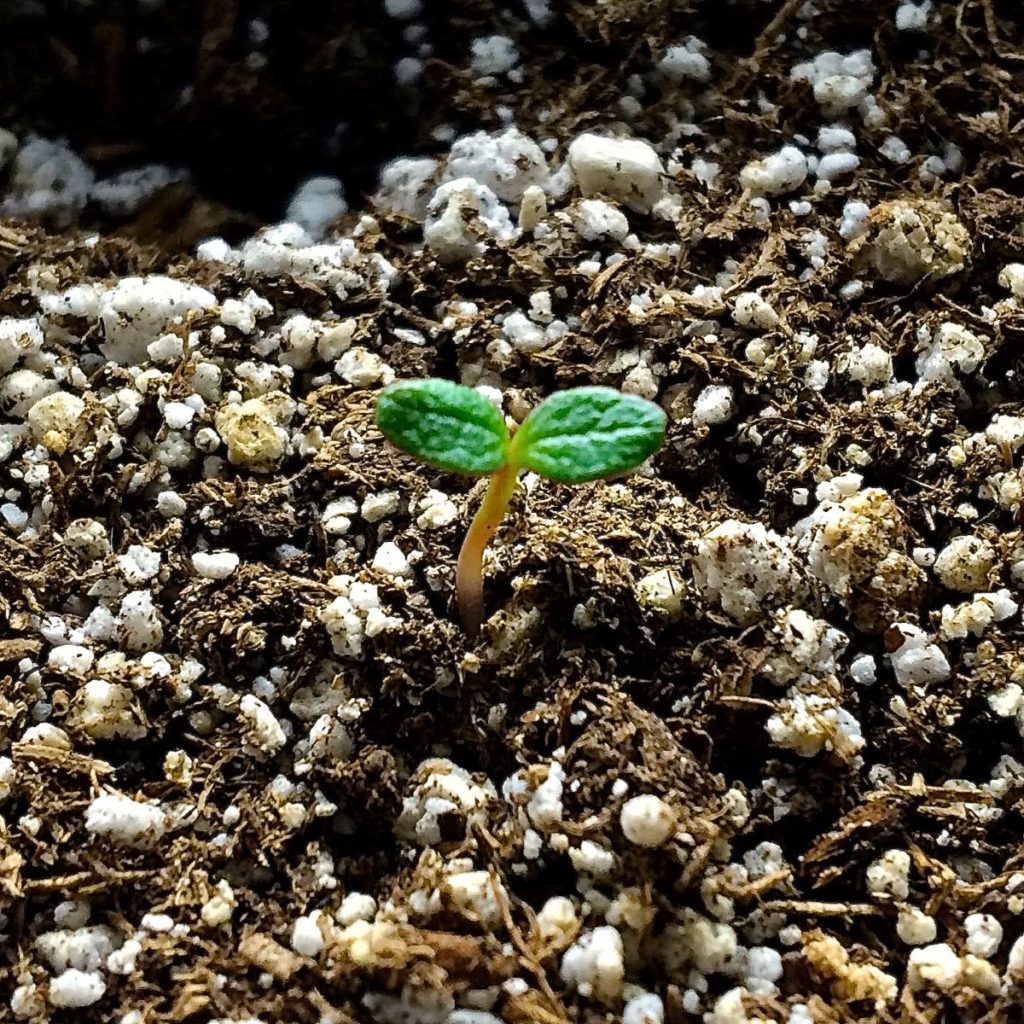
Muñoz (1991) grew seeds provided by the University of Turku and achieved germination in only 12 days using their protocol, which involved soaking the seeds for three days, removing the embryo from the pericarp and disinfecting with 0.2% AMISEPT, and growing on a paper towel wetted with 1000 ppm GA3 at 20 to 25 degrees C.
The optimal conditions for germinating and growing ulluco seedlings are different, so it is best to prick out and transplant seedlings as soon as they emerge. Grow seedlings in regular potting soil at about 60° F. Make sure that they are under light at least 14 hours per day. If they are grown under short day conditions, ulluco seedlings tend to produce tiny tubers instead of true leaves. While the tubers can presumably grow a new plant, they may be too small to survive that long. Seedlings should have three or four sets of true leaves and be a suitable size for planting out in two months.
When fully dried, there are approximately 465 ulluco seeds per gram in seed collected from mixed varieties. Varieties differ in seed weight by about +/- 5%.
Cultivariable Ulluco Seed Germination Results
| Year Germinated | |||||||||
| Year Collected | Total Seeds | 2013 | 2014 | 2015 | 2016 | 2017 | 2018 | Total Germination | Germ/Year |
| 2013 | 121 | 0 | 0 | 2 | 1 | 0 | 3 | 6 (4.9%) | 0.82% |
| 2014 | 1244 | – | 0 | 13 | 12 | 14 | 15 | 54 (4.4%) | 0.88% |
| 2015 | 2281 | – | – | 7 | 25 | 22 | 35 | 89 (3.9%) | 0.98% |
| 2016 | 1519 | – | – | – | 3 | 21 | 31 | 55 (3.6%) | 1.2% |
| 2017 | 366 | – | – | – | – | 0 | 8 | 8 (2.2%) | 1.1% |
| 2018 | 3206 | – | – | – | – | – | 2 | 2 (0.06%) | 0.06% |
| All Years |
8737 | 0 | 0 | 22 | 41 | 57 | 94 | 214 (2.4%) | – |
Harvest
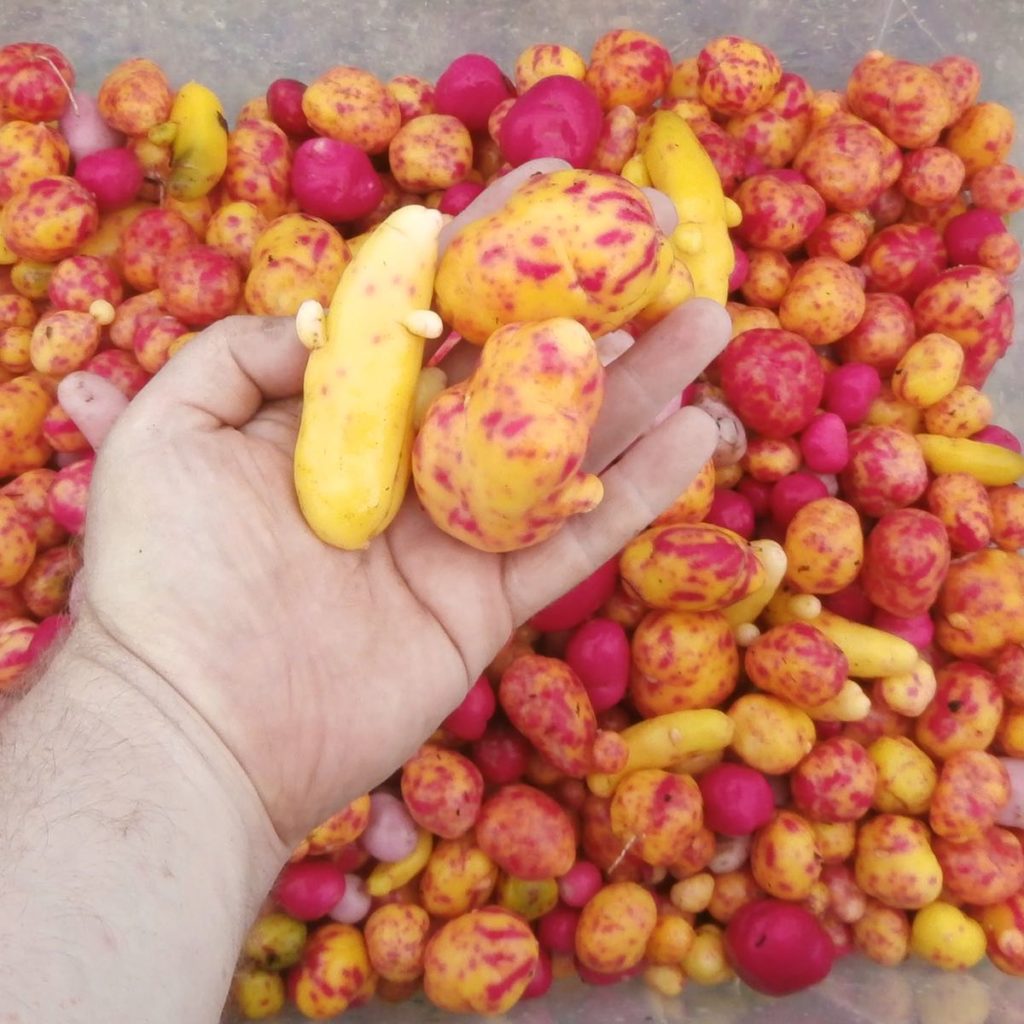
In North America, harvest can be made after the middle of November. This is the earliest harvest that is likely to provide a worthwhile result. You might achieve 50% of the possible yield, roughly 1/2 to 1 pound (227 to 453 g). If you can wait until the first week of December, you will be closer to 80% of the possible yield. 100% comes about in late December or January in climates that are frost free and warm enough for the plants to do more than just survive. We usually schedule our ulluco harvest around December 1st. At full maturity, most varieties form more than 100 tubers per plant, but only about a third of them are of a marketable size (roughly an inch or more in diameter).
If the plants haven’t been killed by frost when you harvest, you can get a secondary crop from ulluco by burying the foliage back in the holes after you dig the tubers. If the soil doesn’t freeze, you can return in 2 to 4 weeks and you will find that many small tubers have formed from the buried stems.
Storage
Ulluco is probably the champion among Andean roots for storage life. Under careful storage conditions of 34 to 38° F (1 to 3 C), 90% humidity, and darkness, ulluco has been known to store for two years. It is pretty easy to get a year out of them.
Preservation
Although it is best consumed fresh and remains so for months in cool temperatures, ulluco also cans very nicely. You can process ulluco for canning just as you would potatoes and enjoy your crop year round. Unlike the other Andean tubers, commercial canned ulluco is widely available in South America and can sometimes be found in specialty food shops in the United States.
Problems
Pests
The two most important pests of ulluco in North America appear to be slugs and field mice (voles). Slugs are primarily a threat when the plants are small, although they can do a lot of damage to even established plantings when present in large numbers. Be vigilant in the first month after planting out. Field mice can be a serious problem because they will chew the stems at ground level, which can leave you with a plant completely severed from the roots. Cucumber beetles have been reported as a serious pest of ulluco where they are present in large numbers. I have seen them in ulluco here on occasion, but I haven’t observed damage.
Happily, I can report that deer show no interest in ulluco.
Diseases
If you read nothing else in this section, read this paragraph: Most heirloom ulluco varieties are infected with viruses. In the past, we tested varieties for viruses that are cross-infectious with potato, since those are the viruses of major concern. In 2016, we started testing ulluco for a wider range of viruses and the results showed that more than 90% of the heirloom varieties available in the US are carrying viruses. Until recently, if you were going to grow ulluco, there was no choice but to grow heirlooms, so we just made do with these unhealthy varieties. Now we have an alternative though. We have been growing new varieties of ulluco from seed for four years now and all of these seed grown varieties have tested clean of viruses (of those that I am able to test for anyway). Because of that, I have stopped growing the heirlooms and I strongly recommend that you avoid them as well.
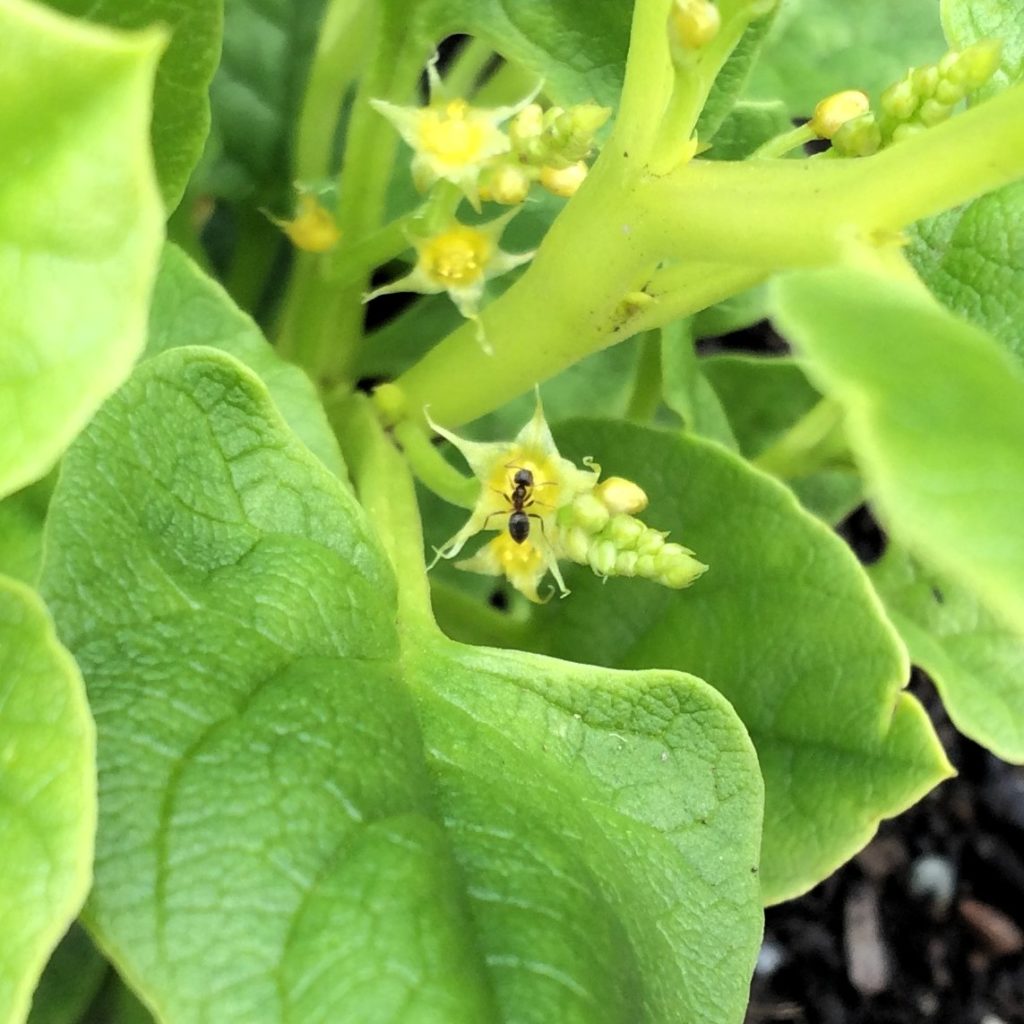
So far, all but one of our seed grown varieties that we have had tested for viruses have been completely clean, even if the parent varieties were probably infected. This is not particularly surprising, as many viruses transmit poorly through seed, but there hasn’t really been an opportunity for anyone to test this with ulluco before now. We have an opportunity to get a clean start with ulluco. Because some of the ulluco viruses transmit very easily, growing the new varieties alongside the heirlooms will result in their infection and decline.
There are a number of common viral, bacterial, and fungal afflictions of ulluco, most of which are not terribly serious, but do reduce yields. Yield increases by using clean seed tubers have been reported in the range of 30 to 50% (NRC 1989). My results have been significantly higher than that, probably because I am growing ulluco outside it’s native environment. Bacterial and fungal diseases can be controlled fairly effectively simply by ensuring that ulluco is frequently watered at ground level, using a drip line, for example. Damp soil and dry leaves is a good combination for ulluco.
Bacteria and Fungi
The most problematic disease of ulluco at low altitudes, in terms of survival and yield reduction, appears to be Verticillium wilt. Most ulluco varieties are very vulnerable to Verticillium, although a few seem to have some resistance. In a cool climate, the plant may be asymptomatic, but as the temperature increases, the symptoms become more severe. Fast wilting under temperatures above 75° F is a likely indication of Verticillium infection.
Because Verticillium is a nearly ubiquitous soil organism, there is no certain way to prevent infection. Verticillium is kept out of seed bank accessions in the Andes by growing the crop at elevations higher than 11,000 feet (3300m), but this is not an option at higher latitudes. Non-organic growers can look into soil fumigants used by seed potato growers to reduce Verticillium populations. For organic growers, the best advice is to rotate annually into ground that has not been planted with Verticillium hosts for two to three years. It is not possible (or at least not practicable) to remove Verticillium from ulluco tubers, so it will always be reintroduced from saved seed tubers.
Growing from true seed can eliminate tubers as a path of reinfection, but even seed grown plants are likely to be infected quickly by this very common fungus. Studies in potato have shown that soil levels of Verticillium are more of a problem than infection within the tubers, so rotation is important even if you are sure that your seed stock is infected. Now that we are having some success at breeding ulluco, it may be possible to develop varieties with greater resistance.
Ulluco is also infected by Rhizoctonia solani, a common potato pathogen. Tubers remain edible but, Rhizoctonia reduces yield, causes dull and cracked skin, and increases storage losses. This fungus persists in the soil and will usually become worse if you do not rotate periodically to crops that it does not infect.
Viruses
Viruses of ulluco are numerous and conspire to ruin yields. Some can be transmitted from potato, so I recommend putting some distance between ulluco and potato plantings. Most ulluco viruses are endemic to the Andes and are only likely to arrive in your garden having been transported in infected seed tubers.
It seems clear that many of the heirloom ulluco varieties in the USA either predate or escaped quarantine. Most ulluco varieties in the USA have been grown since at least the 1990s, before both export and import restrictions made it much more difficult to introduce new varieties from South America. Pica de Pulga is the only variety for which I can find information predating the 1990s, going back to the 1940s at least, although there was also a long yellow variety that might be a match for one of the heirloom varieties. Surveys in the Andes have shown that ulluco is almost ubiquitously infected with UMV, UMMV, and UVC in the southern part of its range and with those three plus PapMV in the northern part of its range, so varieties that escaped quarantine are very likely to be infected with these viruses.
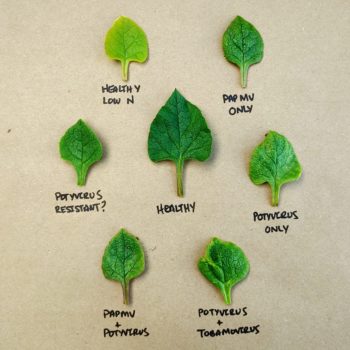
Most of the heirloom ulluco varieties test positive for Papaya Mosaic Virus (PapMV), many also test positive for a Potyvirus that is most like Ulluco Mosaic Virus (UMV), a few test positive for a Tobamovirus that is most likely Ulluco Mild Mosaic Virus (UMMV), and a few test positive for Potato Leafroll Virus (PLRV). I can’t be sure of the identity of the Potyvirus, but I have tested every variety for potato viruses A and Y, which are common potato-infecting Potyviruses, and found them all negative, so I can at least rule those out. It has also been suggested that some varieties might be infected with Andean Latent Virus and Broad Bean Wilt Virus. We have recently (as of 2017) tested our varieties for Andean Latent Virus without finding any infection and will test again in 2018. It is possible that these viruses were present in varieties that we already abandoned. I don’t recommend growing heirloom ullucos. Our new varieties test clean of all the viruses that were common in the heirloom varieties, cover most of the same phenotypes, and perform better, so there is no reason to subject yourself to the risk.
Field tests in South America showed that concentrations of most viruses remain low through the third year following growth from clean cultures (third year seed tubers are typically used for certified seed in potatoes). The exception was potato leaf roll virus, which appeared in more than 40% of plants as soon as the second year (basic seed).
Screening recommendations are provided with the virus descriptions below. These are intended for people trying to produce virus free ulluco stocks. In the USA, I think you can do a pretty good screening by testing just for Papaya Mosaic Virus and Potyviruses. PapMV appears to be the most transmissible by contact and the ulluco Potyvirus (probably UMV) appears to be the most transmissible by aphid. If a variety does not test positive for either one, it probably does not carry other viruses. If it does test positive for either one, then it is fairly likely to be infected with additional viruses as well.
| Virus | Genus | Present in USA | Frequency in Ulluco (USA) | Seed Transmitted |
|---|---|---|---|---|
| Andean Potato Latent Virus (APLV) | Tymovirus | Yes | Rare | Unlikely in ulluco |
| Andean Potato Mottle Virus (APMoV) | Comovirus | No | Unknown/Not Detected | Unlikely in ulluco |
| Arracacha Virus A (AVA) | Nepovirus | No | Unknown/Not Detected | Possibly in ulluco |
| Beet Curly Top Virus (BCTV) | Curtovirus | Yes | Unknown/Not Detected | Unlikely in ulluco |
| Broad Bean Wilt Virus (BBWV1 and BBWV2) | Fabavirus | Yes | Unknown/Not Detected | Unlikely in ulluco |
| Papaya Mosaic Virus (PapMV) | Potexvirus | Yes | Frequent | Unlikely in ulluco |
| Potato Leafroll Virus (PLRV) | Polerovirus | Yes | Infrequent | Unlikely in ulluco |
| Potato Virus S (PVS) | Carlavirus | Yes | Rare | Unlikely in ulluco |
| Potato Virus T (PVT) | Tepovirus | No | Unknown/Not Detected | Possibly in ulluco |
| Ulluco Mild Mottle Virus (UMMV) | Tobamovirus | Probably* | Infrequent | Unknown |
| Ulluco Mosaic Virus (UMV) | Potyvirus | Probably* | Frequent | Unlikely in ulluco |
| Ulluco Virus C (UVC) | Comovirus | Probably* | Rare | Possibly in ulluco |
* Ulluco varieties have tested positive for the genus and this virus is the most likely culprit
Andean Potato Latent Virus (APLV, genus Tymovirus)
This virus is found in ulluco and wild and domesticated potatoes in the Andes and it is present in some heirloom ulluco varieties, which is the main reason why I no longer grow them. We test every known host here for APLV and have never seen it in a potato or in anything other than those ulluco varieties, so I don’t think it spreads easily. In the Andes, it is primarily spread by contact and mechanical means, but is also reportedly spread by flea beetles. Symptoms in ulluco are not described and it may be asymptomatic. It can transmit through true seed, although reportedly at a low rate. It is also said to infect tubers unreliably in potato, so it may be possible to recover clean plants from tubers of infected plants. This virus is a very good reason not to grow the old ullucos or to keep them absolutely isolated from potatoes if you insist on it. No field tests. You should screen for this if you are growing heirloom ullucos. This virus was reclassified as a strain of Eggplant Mosaic Virus (EMV) and then returned to its own species, so you may need to search under both names for information. There may also be other closely related Tymoviruses or strains of APLV than infect ulluco. APLV is a quarantine virus in the USA.
More info: DPVWeb, EPPO, Plantwise
Andean Potato Mottle Virus (APMoV, genus Comovirus)
Probably not present in North America or at least very rare if so. Reported to be rare in ulluco. Symptoms have not been reported. Spreads by plant to plant contact. No field tests. Not worth screening unless you know it is in your collection. APMoV is a quarantine virus in the USA.
More info: DPVWeb (Pictures), EPPO, Plantwise (Pictures)
Arracacha Virus A (AVA, genus Nepovirus)
Probably not present in North America or at least very rare if so. It isn’t clear whether this virus infects ulluco in the wild or only if experimentally inoculated. Symptoms in ulluco have not been published, so it may be asymptomatic. Probably spread by plant to plant and mechanical contact and perhaps by nematodes. May be transmissible through true seed. No field tests. Not worth screening unless you know it is in your collection or possibly if you are growing arracacha of unknown origin.
Beet Curly Top Virus (BCTV, genus Curtovirus)
I have never seen a positive test for this virus, but it was reported to infect the heirloom ulluco variety ‘Spotted White’. Spread primarily by leafhoppers. No field tests. Not worth screening unless you know it is in your collection.
More info: DPVWeb, EPPO, Plantwise
Broad Bean Wilt Virus (BBWV1 and BBWV2, genus Fabavirus)
Broad Bean Wilt Virus has previously been detected in ulluco, but it isn’t clear if this was BBWV1 or BBWV2, which were previously considered to be different serotypes of the same virus. BBWV2 is found worldwide, while BBWV1 is primarily found in Europe and in parts of Australia, Japan, and the USA. Only BBWV2 is found in South America, so that is the most likely culprit, but I don’t know if BBWV1 might infect ulluco as well. ELISA tests do not distinguish between these two viruses. I have not seen these viruses in any ulluco variety, but I have it on good authority that they have been found in ulluco in Ecuador. It is possible though that there is cross-reativity between serological tests for BBWV and UVC, in which case BBWV positive ullucos might only have UVC. No information is available about symptoms in ulluco. Both viruses are probably spread primarily by aphids. BBWV2 may transmit through true seed with low efficiency. No field tests available. It is probably not worth screening for this virus in the USA.
More info: DPVWeb (BBWV1), DPVWeb (BBWV2), EPPO (BBWV1), EPPO (BBWV2)
Papaya Mosaic Virus (PapMV, genus Potexvirus)
This virus occurs in the northern Andes and the USA. This is the most common virus of ulluco in the USA. In the Andes, it frequently infects ulluco in the field. In the USA, it primarily infects papaya in the Southeast, but it also is (or was) present in some heirloom varieties of mashua, oca, and ulluco and can spread relatively easily between them. In papayas, it causes the confusingly named “pawpaw disease,” which has nothing to do with North American pawpaw (Asimina triloba). In ulluco, the primary symptom is often subtle and is simply a dingy appearance to the leaves. They lose their healthy luster and can develop unusual rugosity. Other symptoms can include mild mosaic, red mottling on the underside of the leaves, shallow necrotic pitting, and possibly stunting in combination with heavy flowering. Most ulluco varieties appear to be able to tolerate long term infection, although yield and seed set are clearly reduced. The worst symptoms tend to occur in cases of infection with multiple viruses; this virus can be nearly asymptomatic alone. Probably spreads by plant to plant contact, as is usually the case for Potexviruses. Aphids did not transmit the virus in one experiment. If you insist on growing infected varieties, keep them separated from uninfected varieties by as much distance as possible and do not use the same tools to cultivate or harvest. Field tests are available. This virus is common in heirloom ulluco varieties and I recommend routinely screening for it.
More info: DPVWeb, EPPO, Plantwise, Salazar (2006)
Potato Leafroll Virus (PLRV, Polerovirus)
PLRV is one of the worst common potato viruses and it unfortunately also infects ulluco. If you trade tubers, you are almost certain to get this virus at some point. It is common in seed potatoes and even occurs occasionally in certified tubers. This is a common virus in heirloom ullucos in the USA. There is some information that suggests that ulluco may be infected with a different strain of PLRV than potato, so it isn’t clear whether the strain that commonly infects potatoes can spread to ulluco. It appears to be asymptomatic in ulluco, except perhaps for a slight yellowing of the leaves in some cases. Poleroviruses are primarily spread by aphids, which are persistently infected. Some studies have shown that this virus infects ulluco incompletely, so it may be possible to recover healthy material from infected plants. I think this is a virus that most collectors should screen for. Unfortunately, there is not a field test available for this one, so you will need to use ELISA to test for it.
More info: DPVWeb (Pictures), EPPO, Plantwise (Pictures)
Potato Virus S (PVS, genus Carlavirus)
PVS is a very common mosaic virus in potatoes. It is apparently able to spread to ulluco from potato, as it turned up here in a previously indexed and healthy, seed-grown ulluco variety. The symptom was irregular leaf shape in the new growth. As far as I know, PVS had not previously been reported to infect ulluco. The infection was first detected with an Agdia Immunostrip and later confirmed by ELISA. Tubers collected from the infected plant later tested negative, so this virus may be poorly adapted to ulluco. Primarily spread by aphids and plant to plant contact. Field tests are available. It doesn’t appear to spread to ulluco very easily, but if you are growing potatoes and ullucos, it couldn’t hurt to screen both.
More info: DPVWeb, EPPO, Plantwise (Pictures)
Potato Virus T (PVT, genus Tepovirus)
PVT is native to the Andes, where it infects several of the Andean tuber crops, including ulluco. Symptoms in ulluco have not been reported. It is somewhat common in oca in the Andes and is known to spread through true seed and pollen. Transmission occurs from pollen to seed without infecting the parent plant. It can also be spread mechanically but is not known to be spread by insects. I have not seen a positive test for PVT from ulluco (or anything else) in the USA. No field test available. There is probably not a compelling reason to screen for PVT in the USA, but I test for it anyway, because viruses that spread through true seed make me nervous. PVT is a quarantine virus in the USA.
More info: DPVWeb, EPPO, Plantwise
Ulluco Mild Mottle Virus (UMMV, genus Tobamovirus)
A virus mostly restricted to South America, although it wouldn’t be surprising if heirloom ullucos carry it in other regions, given that they are often infected with other viruses that are commonly associated. UMMV was initially described as a strain of Tobacco Mosaic Virus (TMV/U), but as far as I can tell, TMV does not infect ulluco. I have not seen a positive result for Tobamovirus in heirloom ullucos since I began more comprehensive testing, however some of the older heirloom varieties in the USA that I discarded developed a weak positive with serological tests for Tobacco Mosaic Virus and my best guess is that is probably due to the presence of UMMV. This virus may be asymptomatic or may cause chlorotic rings and markings or even systemic chlorosis. May result in a yield loss in the vicinity of 20%. Transmission is probably primarily by plant to plant or mechanical contact. Aphids did not transmit the virus in one experiment. The virus does not infect potato, so that at least is good news. Field tests are available for Tobacco Mosaic Virus and I recommend screening for that even though we don’t necessarily know what might have generated the previous positives. Whatever it is, you don’t want it. I am of the opinion that all heirloom ullucos should be screened once for Tobamoviruses by PCR, although that is a considerably more expensive option. Although not much is known about the severity of this virus, Tobamoviruses often have a wide host range and can pose a significant contamination risk because they can persist in the environment in an infectious state for a long time, perhaps years. Tobamoviruses also have a tendency to contaminate the seed coat, so it is important to ensure this virus is not present in varieties that are used for seed production.
More info: EPPO, Brunt (1982)
Ulluco Mosaic Virus (UMV, genus Potyvirus)
Very little information has been published about this virus. It is presumably found mostly in the Andes, but I suspect that it is carried in many heirloom ulluco varieties, which produce a low titer positive result for a Potyvirus that is not any of the common potato Potyviruses. UMV is reported to cause obvious mottling and some leaf distortion. Transmission is likely to occur by aphid and by contact, as is often the case for Potyviruses. This virus has not infected potato through experimental inoculation. No field tests or ELISA are available, but group Potyvirus tests routinely produce a low indicator positive result and I think the most likely explanation is UMV. I recommend screening ulluco for Potyviruses.
More info: Brunt (1982)
Ulluco Virus C (UVC, genus Comovirus)
A virus mostly restricted to South America but it may be present in some heirloom ulluco varieties. Alone, it is reported to be symptomless in ulluco, but it may intensify mosaic symptoms when more then one virus is present. No specific vector is known and it is not aphid transmitted, but Comoviruses are typically spread mechanically and by beetles. We once got a positive test for Comovirus in a seed grown ulluco with no outdoor exposure, which makes me suspect that UVC can transmit through seed. It is always possible that it was a false positive though; I decided to destroy the plant, so there was no opportunity for confirmation. This virus has a narrow experimental host range and is probably the least concerning of the common ulluco viruses. It does not infect potato. No field tests are available. It may be possible to detect this virus with ELISA for Cowpea Mosaic Virus, although it would be more reliable to get PCR for Comoviruses. Probably not worth screening for in the USA.
Defects
Ulluco tubers are often chimeras: mixes of cells with differences in their genetic composition. Because of this, you must be careful to propagate tubers that look similar to the material that you started with. For example, spotted tubers sometime produce solids and the solids then produce a greater percentage of solids. Before too long, you can end up without any spotted tubers.
Breeding
Crop Development
Ulluco is somewhat limited as a crop in North America by a combination of factors: its low tolerance for hot weather, it’s relatively long cropping time, its short day requirement for forming tubers, and its lack of frost resistance. Breeding efforts that target these limitations should result in a crop that can perform better in continental climates.
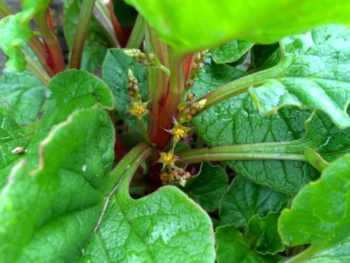
In North America, the most crucial problem with ulluco is it’s lack of tolerance for temperatures in excess of 80° F (27 C). Even in climates with mild autumn weather, it may fail to thrive due to the preceding high summer temperatures. Ulluco may fail completely if temperatures above 80° F continue for weeks and, even if it survives, it usually yields poorly if the cool weather recovery period before tuber formation is short. In combination with a long time to maturity (ulluco requires about six months in the ground), temperature sensitivity makes for a challenging crop in all but the mildest maritime climates. A significant reduction in the time to maturity could help to mitigate temperature sensitivity by allowing ulluco to be grown as a fall/winter crop in frost free climates.
Part of ulluco’s vulnerability to warm temperatures may be related to its lack of resistance to Verticillium wilt. Evaluating existing clones for Verticillium resistance and prioritizing breeding with those varieties could be a path to better performance.
Eliminating ulluco’s short day requirement would result in a plant that would form tubers earlier in the year, which would have two significant effects: it would make it possible to grow ulluco in areas with early frosts and it would improve yields in areas with later frosts, by allowing ulluco tubers to continue growing for a crucial extra month or two. A completely day neutral ulluco could be grown through the winter for spring harvest, providing more favorable weather in frost free areas.
Potatoes were bred into today’s day neutral varieties from stock that was originally short day adapted, so we know that such a change is possible, but we don’t know what the odds are. We might find an ulluco seedling that has become day neutral in a single generation, or we might have to take the slow route by breeding varieties that are a few days earlier, gaining additional days with each generation. Varieties have been reported in the Andes that form tubers at a critical day length of 13.5 hours (NRC 1989), which would be a great improvement for cultivation in North America. None of the varieties in our collection begin forming tubers at day lengths longer than 12.5 hours.
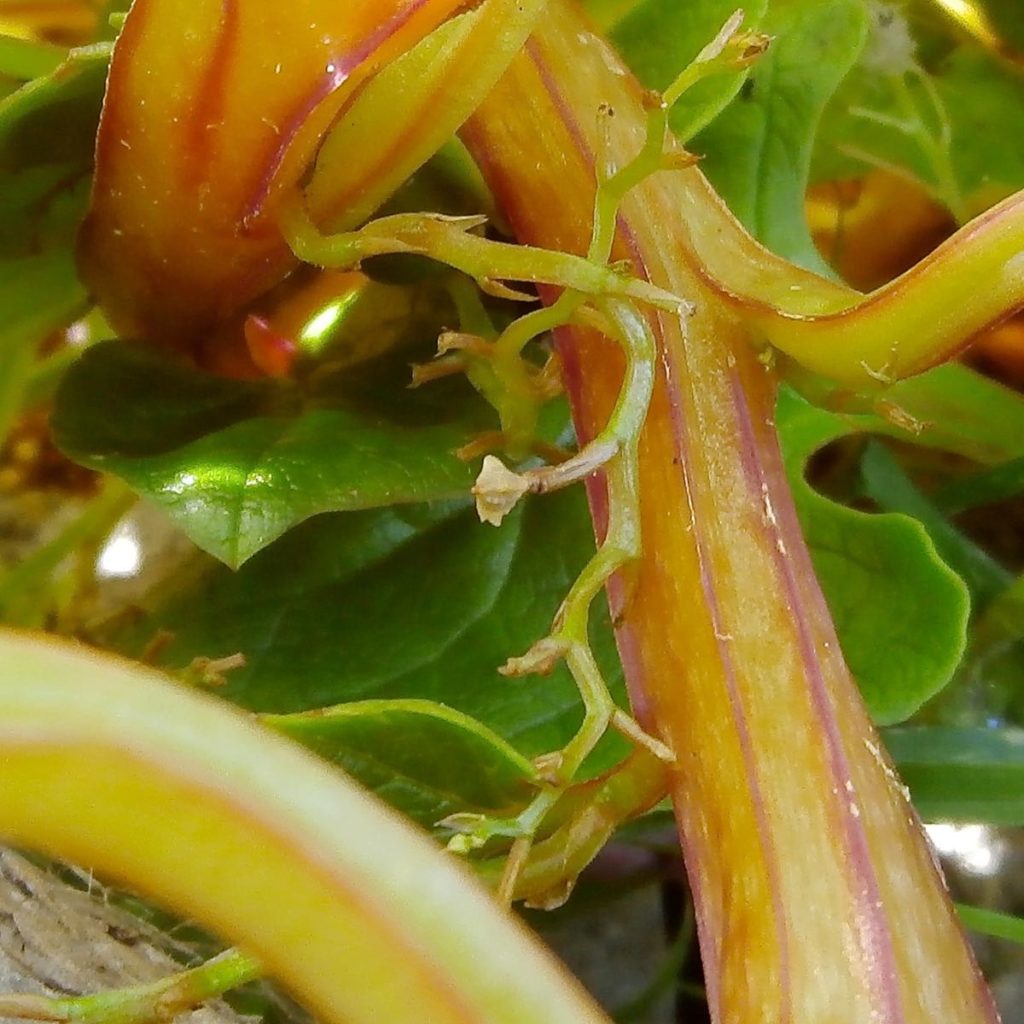
Another possible route to improved yield would be better frost resistance. Breeding frost resistance into plants that don’t already have some has proven to be difficult in most cases. However, a few sources report a small degree of frost resistance in ulluco in the Andes. Varieties currently available in North America show no significant frost resistance. Ullucos that could survive light frosts might have a month or more of additional time to bulk tubers, which could make a significant difference in yield.
Increasing the average tuber size would be a big improvement for a variety of reasons. Very small tubers are generally not marketable, so this output from the plant is wasted. The very small tubers can also be difficult to manage in climates where the soil doesn’t freeze deeply, as they will overwinter and potentially act as a reservoir for diseases. Fewer, larger tubers would also improve the prospects for machine harvest of the crop. One possible route to this might be by reducing the number of descending stolons. The tubers that are borne on underground stolons are usually the largest.
In the New Zealand breeding program, one of the objectives is low geosmin content (Pathirana 2011). This seems like a mistake to me, as it will rob ulluco of its signature taste, but perhaps I am underestimating the dislike that some consumers have for this flavor. It seems that anyone who likes beets will also like full flavored ulluco.
Perhaps the most interesting path for new variety development over the long term is the selection of stable varieties or hybrids that can be grown annually from seed. Unlike the rest of the Andean tubers, ulluco is primarily diploid, so producing varieties that grow uniformly from seed should not be significantly more difficult than for other crop plants, at least once we have a population of plants that seed well to work from. The first step will be to find varieties that have some level of self compatibility from which to develop inbred, substantially homozygous lines. From those, predictable F1 hybrids could be developed and eventually stable open pollinated varieties. While it seems unlikely that seed propagated ulluco varieties would ever supplant tuber propagated varieties, they would offer certain advantages, particularly where accumulation of diseases in the tubers is a problem.
Crossing wild ulluco (U. t. subsp. aborigineus) with domesticated ulluco might introduce interesting traits. Plants with a trailing habit do turn up from seed, but wild ulluco has much longer vines. Wild ulluco also has a different tuber color than the domesticated varieties. Some accessions grow at higher altitudes than domesticated ulluco and might have some frost resistance. The primary obstacle in making such crosses is that wild ulluco is triploid. Crosses between diploids and triploids have a very low probability of success. Chemical doubling of ulluco has been reported (Viehmannova 2012). It should be possible to double wild ulluco triploids to hexaploids. Crosses between diploid domesticates and hexaploid wild ullucos should produce hybrid tetraploids.
Genetics
Ulluco has unique pigments (betalains) that act as antioxidants and may be nutritionally important. It should be possible to breed for greater concentrations of betalains in skin and flesh. Although more work will need to be done to confirm it, I am working under the assumption that ulluco color inheritance is similar to beet. I have yet to observe a result that contradicts this assumption, although I have only been able to produce a small number of test crosses.
Thus far, all seedlings with green hypocotyls have produced white tubers. White tubers have also been produced by seedlings with red hypocotyls. I assume that this indicates that green hypocotyl seedlings are homozygous recessive for red and that red hypocotyl seedlings with white tubers are at least heterozygous for red. Seedlings with red hypocotyls produce only red or white tubers. I describe seedlings with a range of hypocotyl colors from muddy pink to yellow to orange as brown. These seedlings produce yellow or orange tubers. The hypocotyl color sometimes starts out light green and darkens over time, so it is best not to record hypocotyl color until the seedlings are at least a week old. Red blotching sometimes appears on the hypocotyl and undersides of the cotyledons. While this has been a fairly rare trait so far, it has correlated with blotchy tubers. It appears that useful seedling screening can be done as early as the second week. For example, I have limited interest in white ullucos, so I may eventually decide to cull all seedlings with green hypocotyls. On the other hand, those green hypocotyl seedlings are useful in test crosses because they are homozygous recessive for red and yellow.
| Hypocotyl Color | Tuber Color | Possible Genotype |
| Green | White | rryy |
| Red | Red | R-Y-Bl- |
| Red | White | R-yyBl- |
| Brown | Yellow, Orange | rrY-Bl- |
Relatives
Although they are not particularly close relatives, the family Basellaceae contains two other genera, Anredera and Basella, both of which have edible members that are better known and more widely spread than ulluco.
Anredera
There are a number of species in the genus Anredera, most of which are native to the Andes region, although often at lower elevations than ulluco. They are mostly climbing vines, but they have some similarities in form to ulluco. The most well known species is Anredera cordifolia, an infamous invasive ornamental throughout the temperate world. A. cordifolia is underappreciated as an edible. Some varieties form heavy yields of tubers and they do so without regard to day length. The tubers are revoltingly slimy if eaten raw, but they take on a similar texture to ulluco when cooked. A. cordifolia comes in similar ploidy levels to ulluco, with diploid and triploid populations at least. If it is possible to hybridize any species of Anredera with ulluco, it could be a path to valuable traits such as improved heat tolerance or day neutral tuberization. I have obtained three different accessions of Anredera cordifolia from sellers in the USA and each one tested positive for Potyvirus. I don’t know any more details, but I recommend being careful with this plant, particularly until the specific virus is identified.
Basella
Basella alba, Malabar spinach, is probably the best known of ulluco’s relatives. The Basellas are native to India and are probably a less likely bet for successful hybridization with ulluco than the South American Anrederas, but they are still worth a try. Basella alba is a well known tropical leaf crop, with leaves very similar to ulluco. If hybridization were possible, it would probably be a good source of improved heat tolerance.
Learn More
There aren’t many good sources of information about ulluco on the web. Here are some of the best that I have found:
- Download a free PDF of Lost Crops of the Incas. It is a great introduction to Andean crops, although somewhat out of date.
- Check out Crap Crops of the Incas on Radix, a classic!
- The International Potato Center catalog of ulluco accessions (in Spanish)
- The PROINPA catalog of ulluco accessions (in Spanish)
- Ulluco Morphological Descriptors (in Spanish)


The short day requirement for tuber formation interests me. Back in the 1960’s, a genetic’s professor artificially induced multiple mutations in Hibiscus sabderiffa seeds by various levels of radiation at Oak Ridge, Tennesee. Many mutations were deleterious/lethal mutations, but screening by planting seeds out in North Carolina and watching for those that were day length neutral yielded positive results. This work was done by Dr. M. Pfluge Gregory at N. C. State. From then on people could enjoy roselle calyx products that previously had needed a much longer growing season.
Yes, it is really interesting. Most of the Andean tuber crops, including the potato have a short day requirement for tuberization. This can be overcome, as you noted, but it usually isn’t easy. The problem with ulluco is that it sets such a small amount of seed that you can’t get the large number of progeny that increase the odds of hitting such a chance mutation.
I have never seen such a complete description of plants from all points of wiew: botanic aspect, chemical components an so on..Thank you so much!!!
I recently got some Ulluco tubers are am planting them out this year. I would really like to try my hand at getting a few seed. From what I understand viruses (as well as genetic load) probably contribute to the low seed set. Can you recommend any tissue culture (or other) methods for cleaning the material or viruses?
If we sell any seeds this year, they will be available around November. They are very hard to produce and thus extremely expensive, but the last couple of years I have sold some excess seeds where I was uncertain of the parentage.
The biggest problem with cleaning ulluco is the expense and difficulty of testing for unusual viruses. It often takes multiple rounds of tissue culture to get a clean result. After tissue culture, plants often look healthy and behave as if they are clean for the whole growing season, but still test positive. The most common viruses that we have found in testing are potato leafroll virus and a Comovirus (probably Ulluco Virus C). Potato leafroll virus cleans up pretty well with even simple tuber thermotherapy but the rest don’t. We have also less commonly seen Andean latent virus, papaya mosaic virus, a potyvirus, a tobamovirus, and a nepovirus. We could probably make a pretty good guess about the identities of those viruses, but without specific ELISA tests available, I can’t know for certain. The comovirus and tobamovirus are very difficult to clean, in my experience. On the whole, I decided that it was better to stop playing with fire and just focus on our seed grown varieties, all of which have tested clean so far. I would have liked to maintain a larger collection of heirloom varieties, since we got seed from a relatively small number of them, but ulluco breeding is so rare that I decided that it is better to protect what I have accomplished than to expand it. Hopefully the International Potato Center will be able to clean up their ulluco collection and make it available in the future. That is probably the best hope for getting more ulluco germplasm to work with.
You can find a tissue culture protocol for ulluco in this paper: http://citeseerx.ist.psu.edu/viewdoc/download?doi=10.1.1.201.5057&rep=rep1&type=pdf
I had the best success in virus cleaning with a fairly long term strategy. Store the tubers at low temperature (38F) for two years. Most will survive. Then move the tubers to an incubator set to 97F/36C for 40 days. Many of the tubers will die, but some will survive and sprout. Take your meristems for tissue culture from those tubers. Culture as described in the paper with the addition of 50mg/L ribavirin to the medium. Take explants and culture on media without ribavirin. Unless infected by the comovirus or tobamovirus, at least some of the plantlets should turn out clean. There are probably more effective ways to do this, but it has worked well enough for me to make some progress.
Wow, I wasn’t expecting such a long (2 years plus) protocol. I don’t have enough tubers right now to do this so I will propagate this year and try my hand at crosses anyway. I will let you know if I get some seed, I am based in Cologne so the climate is cool temperate and should suit Ulluco seed set (hopefully). Thanks a lot for your detailed response, much appreciated.
Thank-you!
Good morning,
Where can I buy olluco seeds? Is there a website that I can go to?
Thanks!
When we have ulluco seeds, they are available at the link. It is possible that we will have some this fall, but I am not able to produce enough to sell every year.
https://www.cultivariable.com/product/ulluco/ulluco-seeds/ulluco-true-seeds/
In Valley of Sun/Phoenix, growing cacti inc prickly pear, pitahaya, as well as beets, malabar spinach, mashua, oca, ulluco, potatoes, nimas native sw potato. The mashua, oca, ulluco, potatoes, and nimas I have on special mounds under hoops intercropped with wetloving native grasses so as to keep cooler and wetter than other crops around, more humid, lots of indirect/filtered light. They seem to be thriving, the oca has produced a nice root crop, the mashua great greens with kind of unimpressive roots, and the ulluco just sad little leaves and almost no root growth. I am chopping up ulluco leaves and stems and planting to see about getting something, and I also have ulluco near malabar spinach to see about maybe some kind of hybrid that can handle our heat. Does anyone know the most heat tolerant kinds of ulluco?
There is very little variance in ulluco heat tolerance. They just don’t like warm weather. I’m surprised that mashua is thriving. You must be right on the edge of tolerance. Ulluco is the least heat tolerant of the Andean root crops, but mashua is just ahead of it.
Mark Lewis
I am about an hour north of you in Wickenburg, and am interested in these crops also. Would like to talk with you about what you are doing.
How do I get seed.